
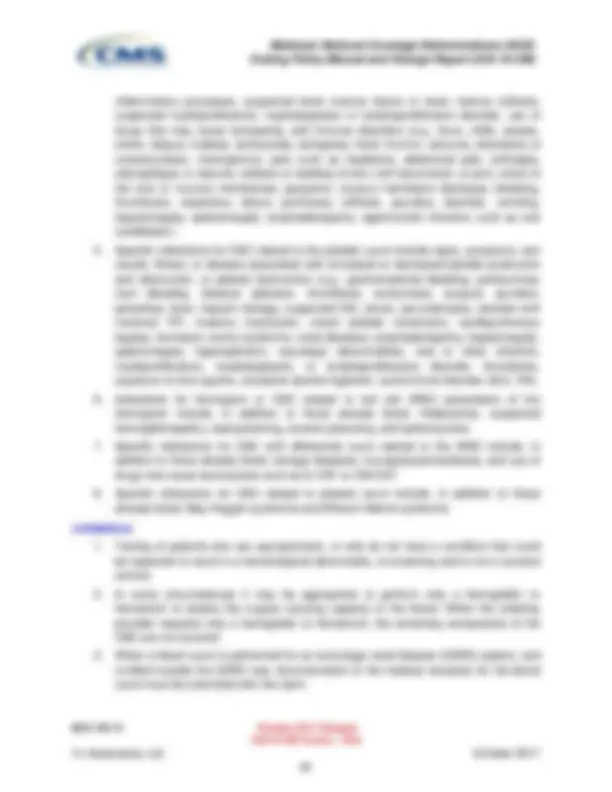
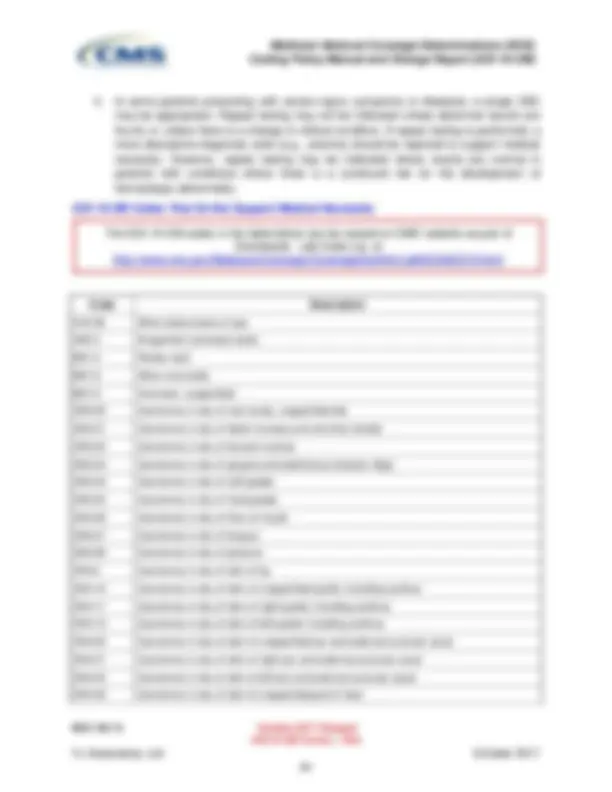
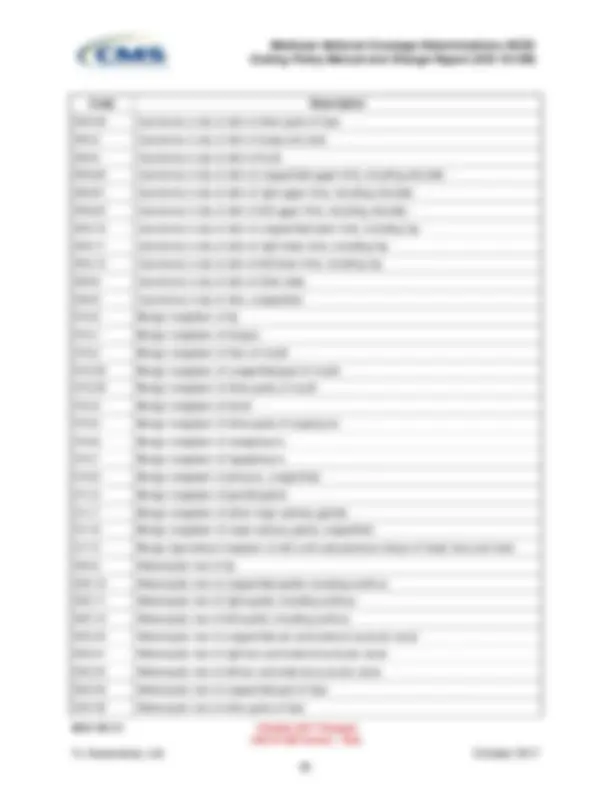
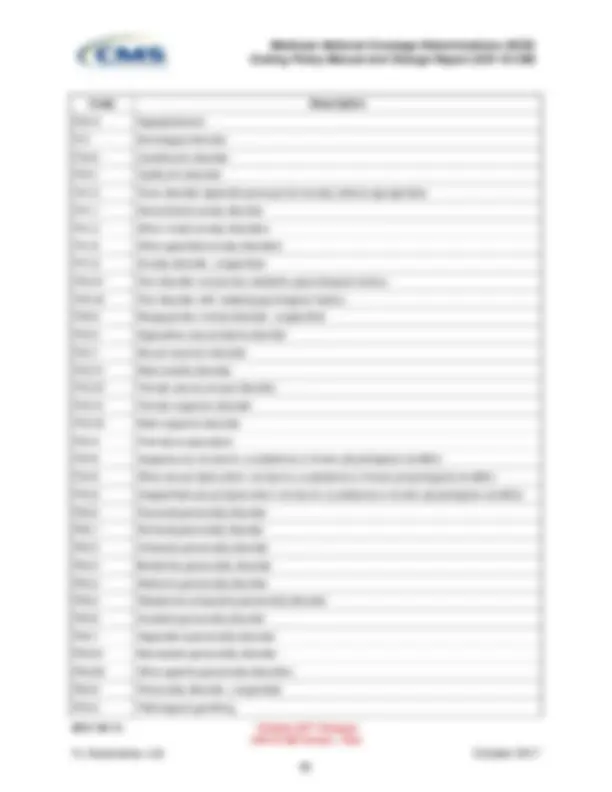
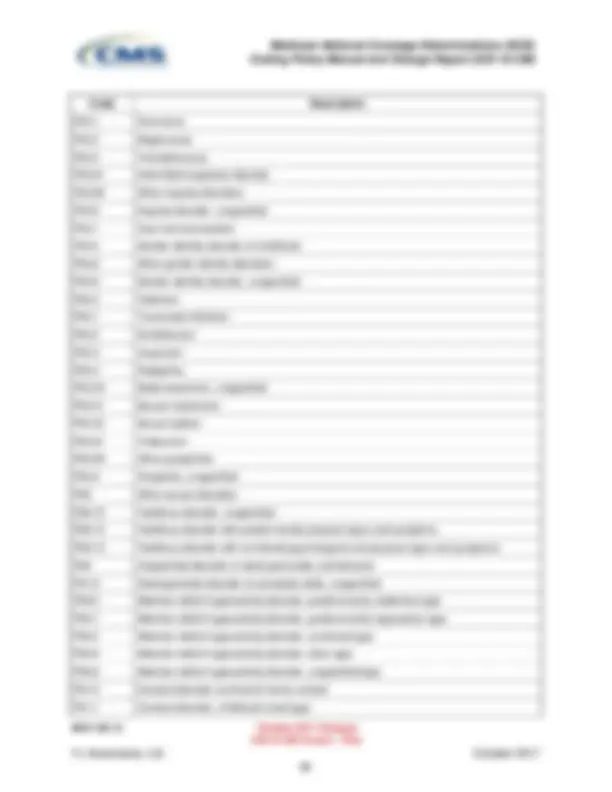
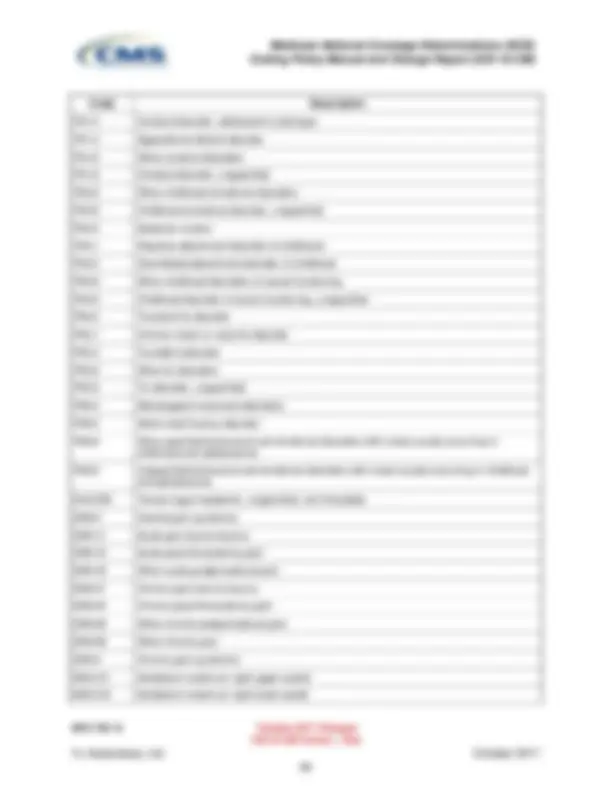
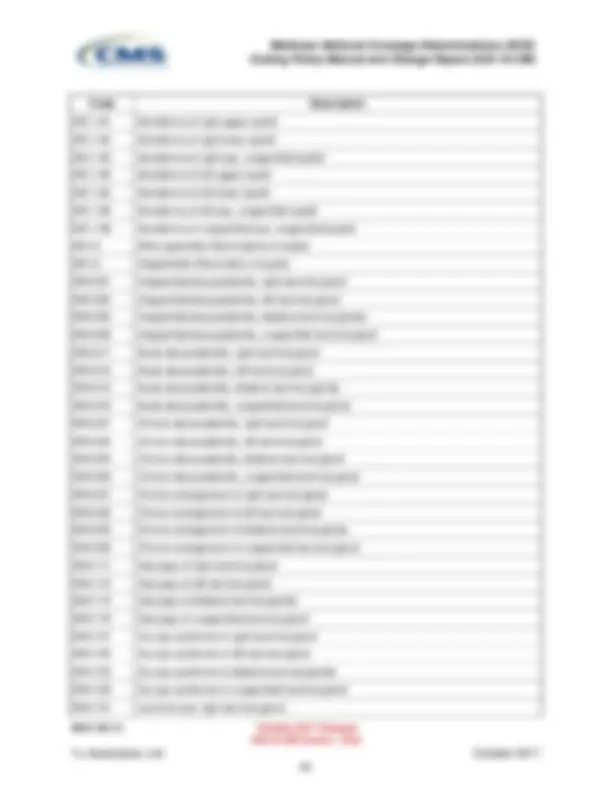
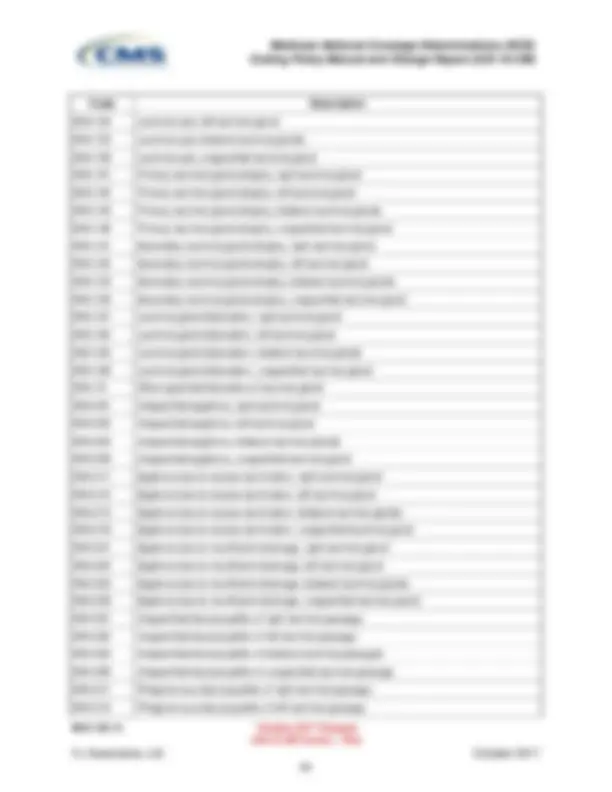
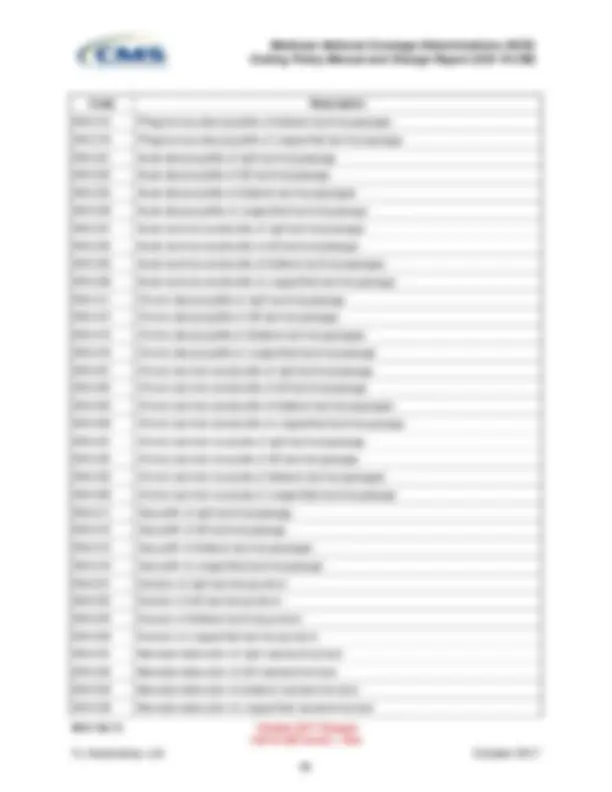
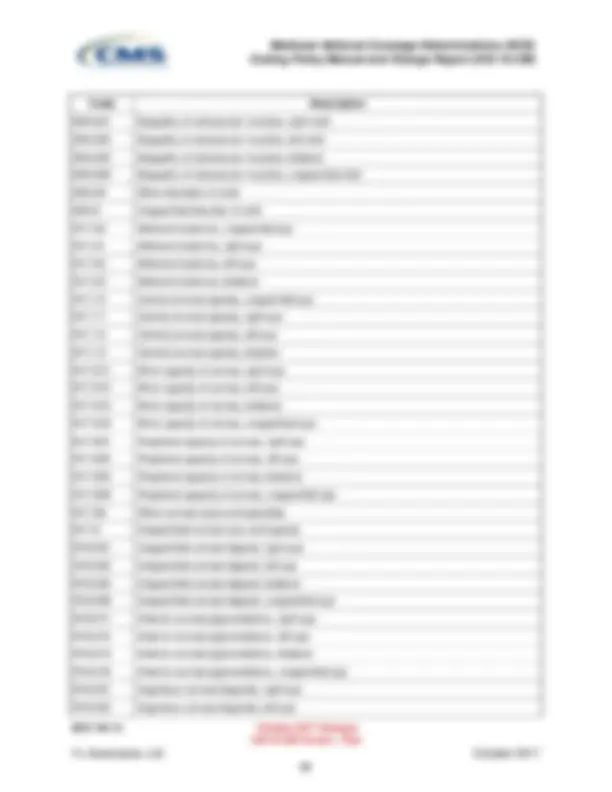
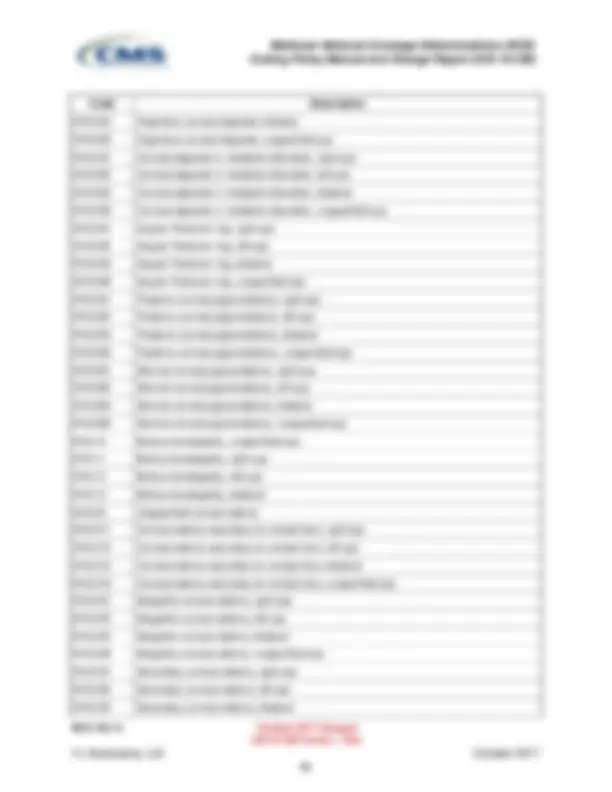
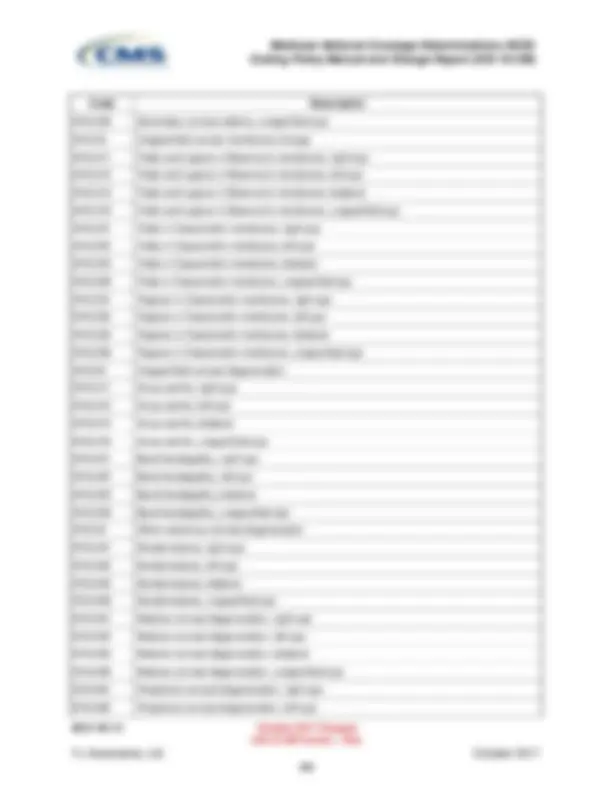
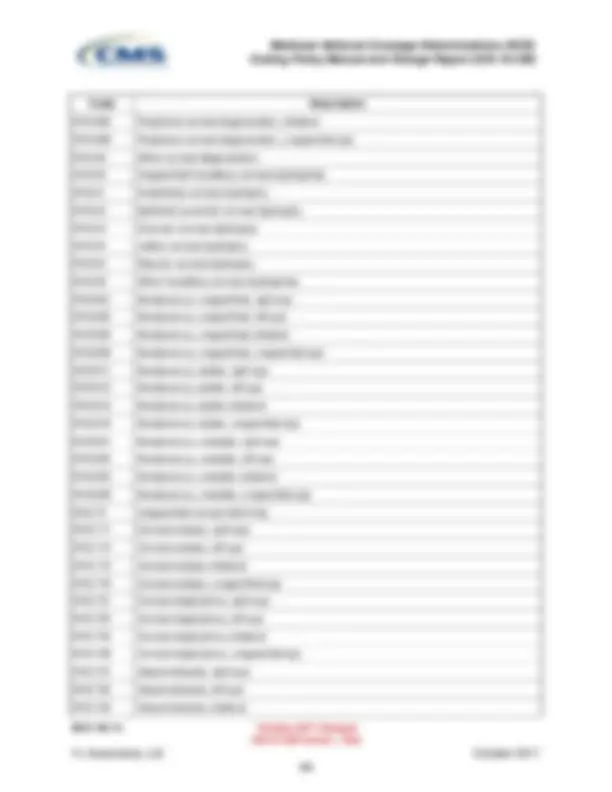
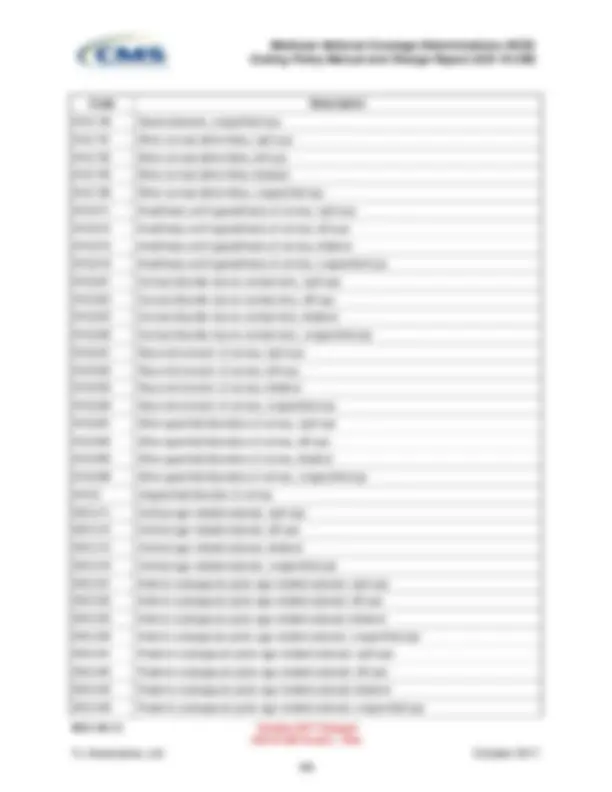
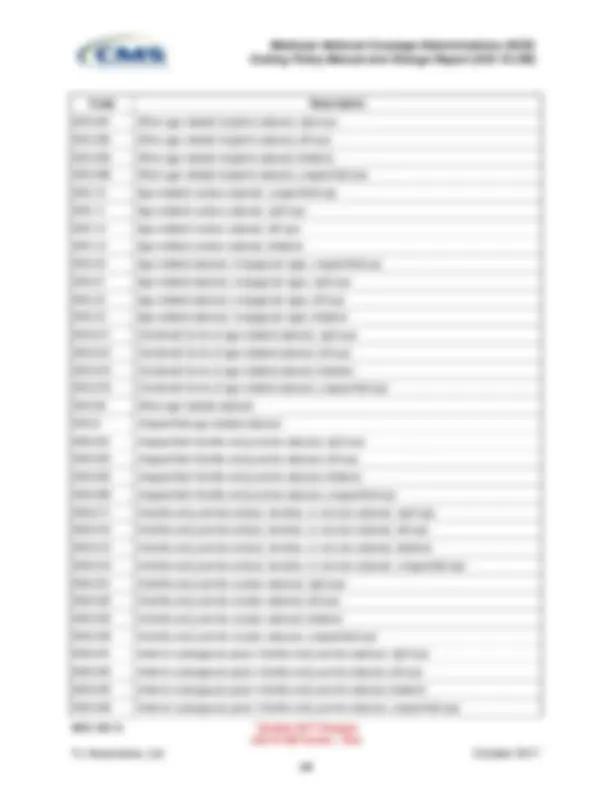
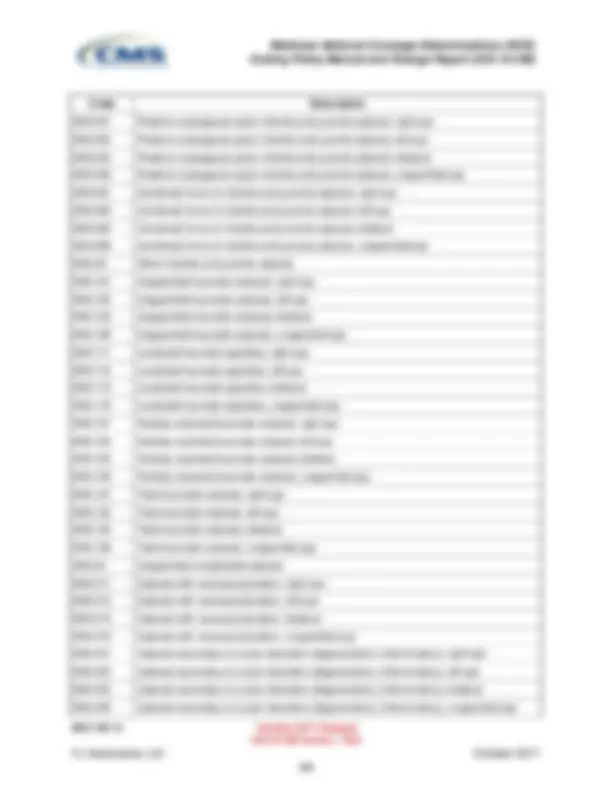
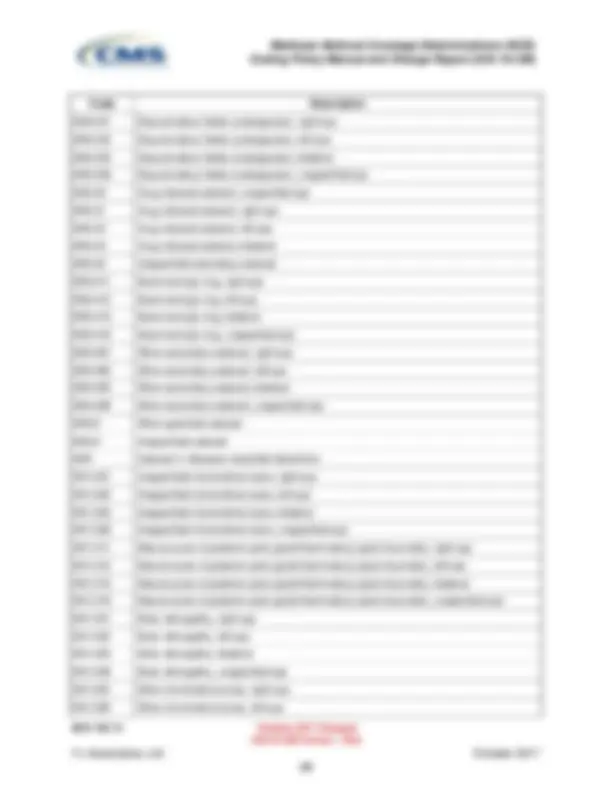
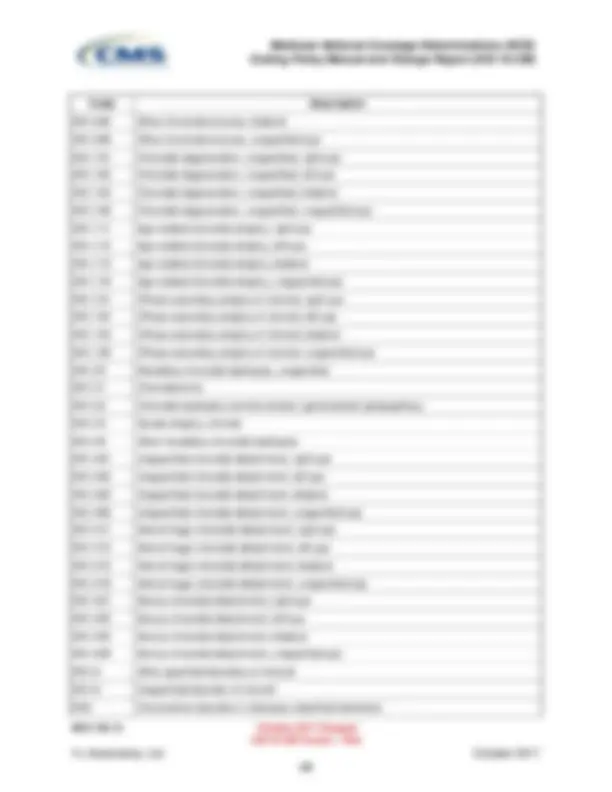
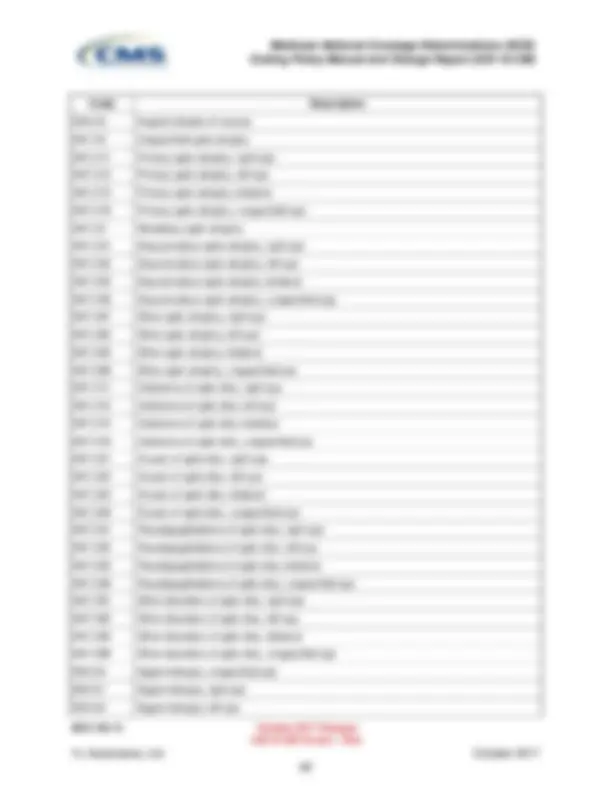

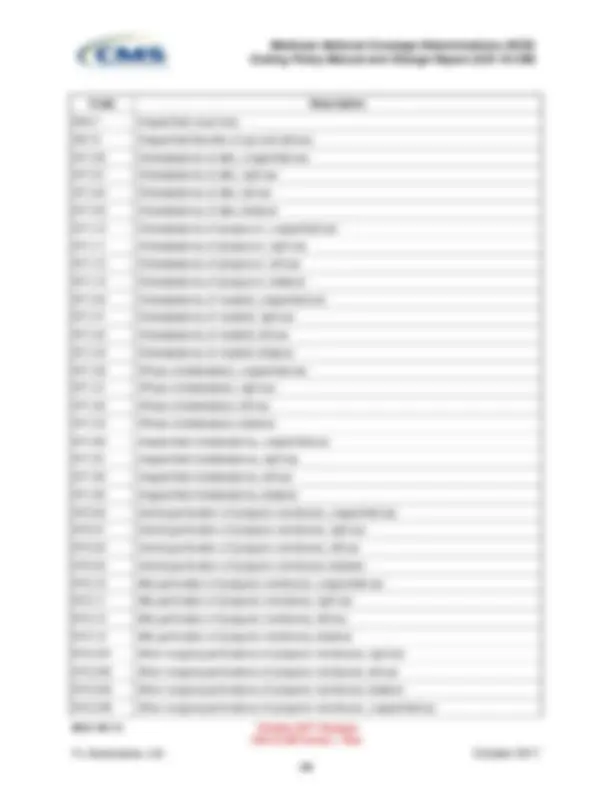
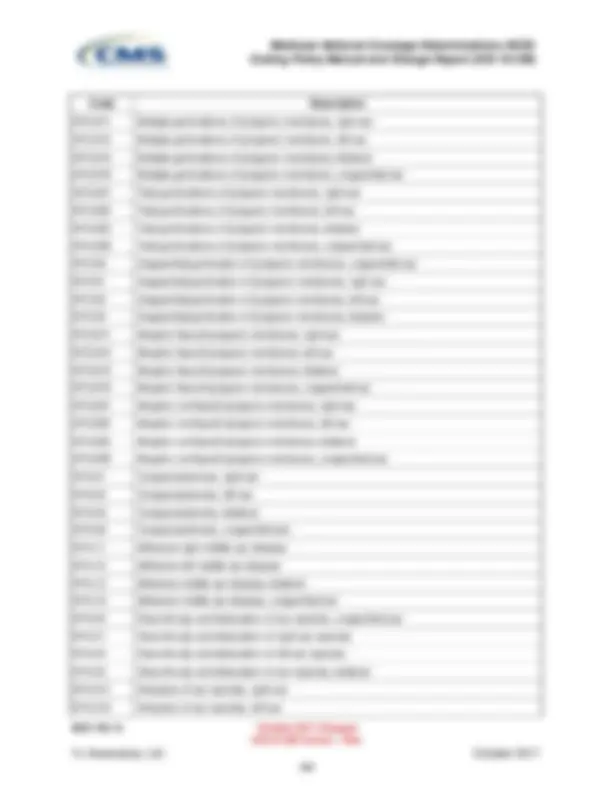
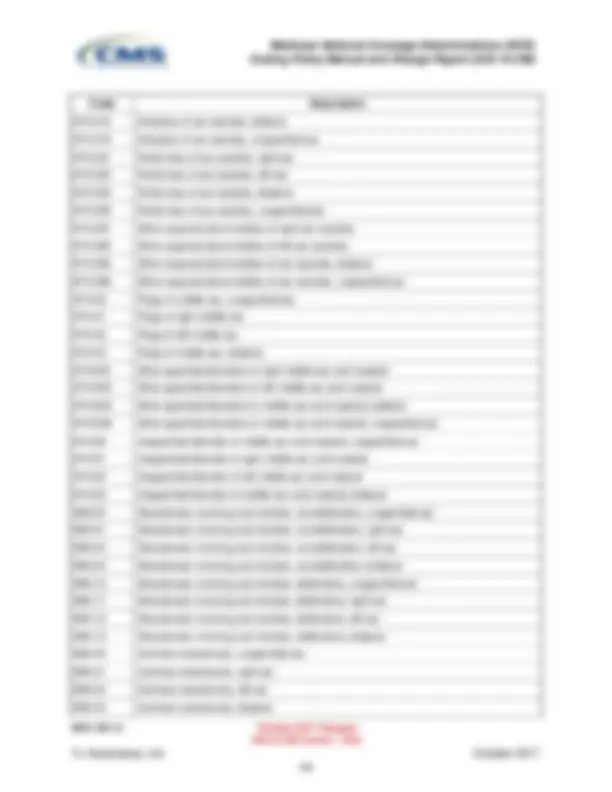
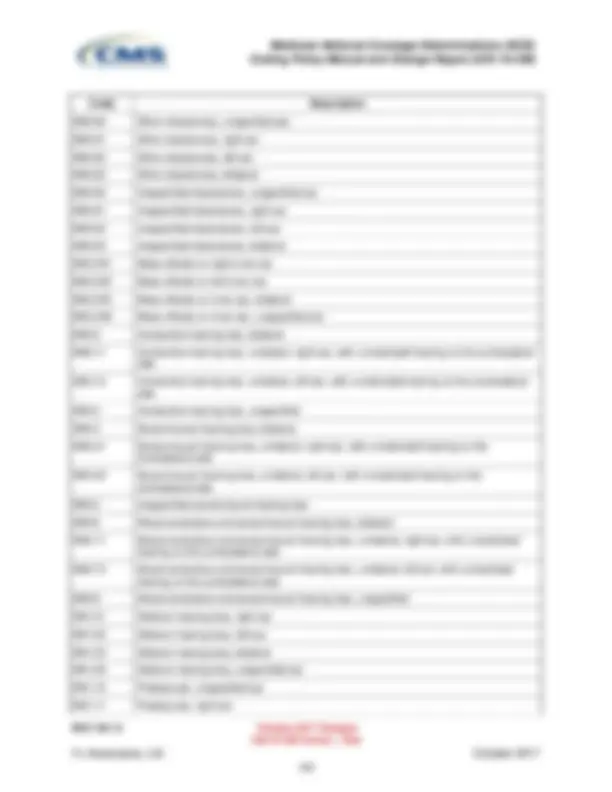
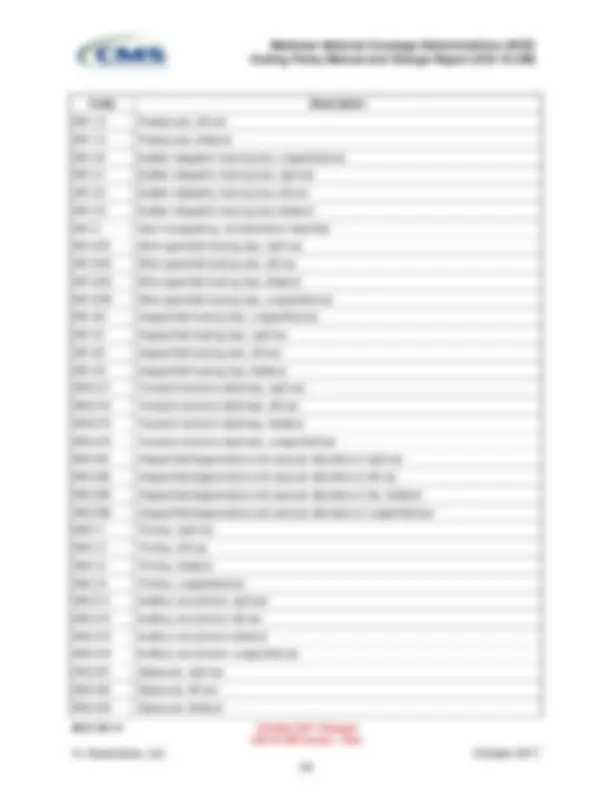
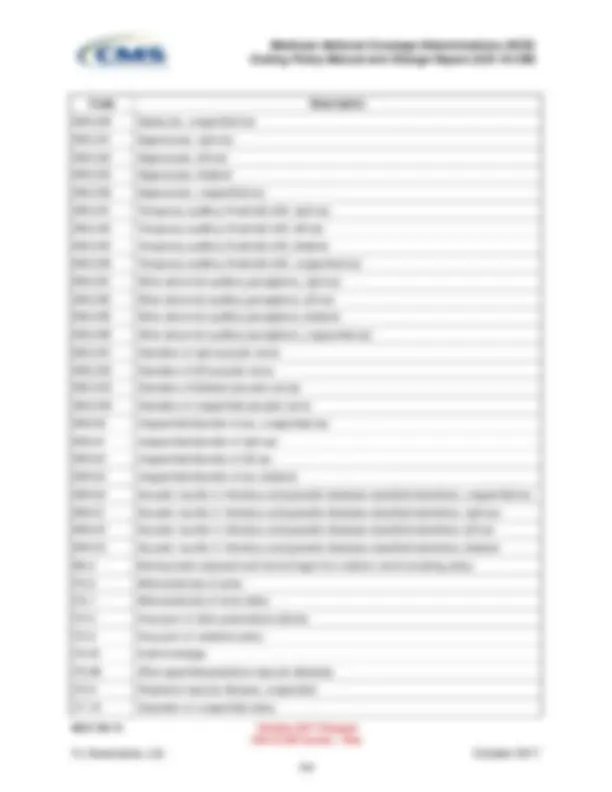
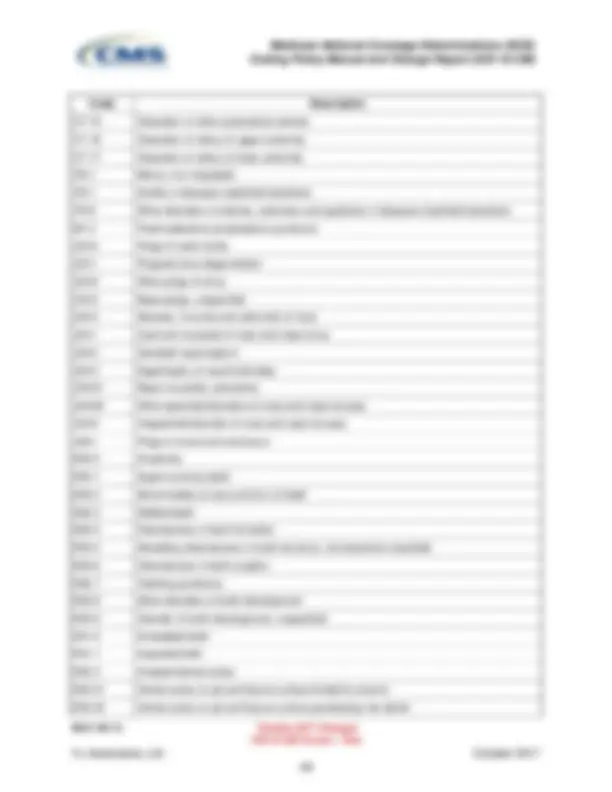
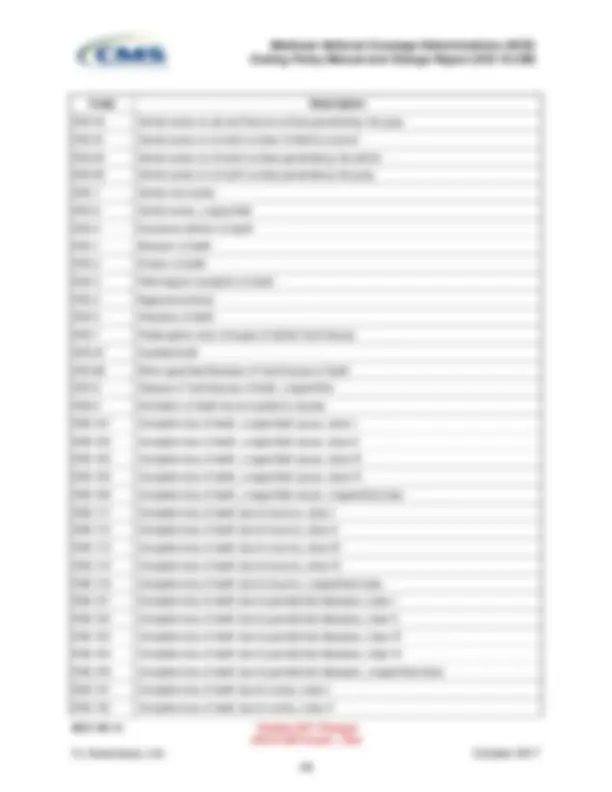
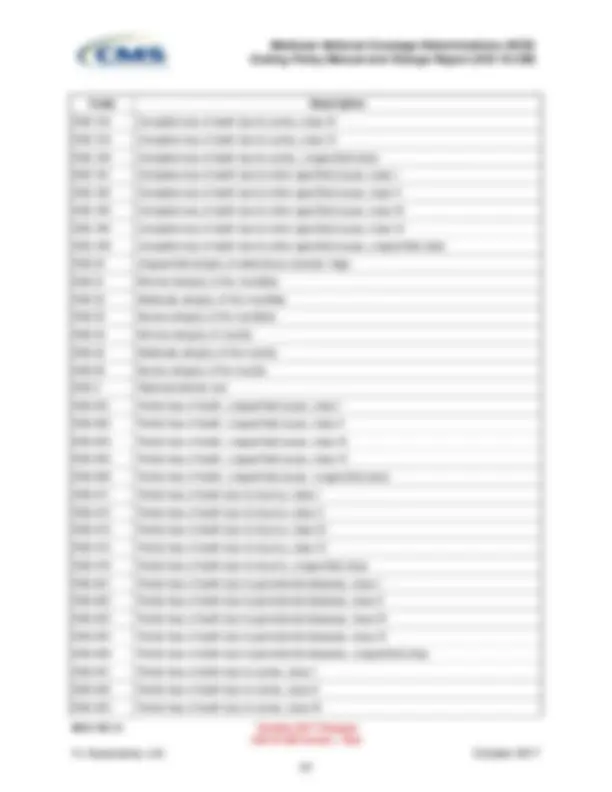
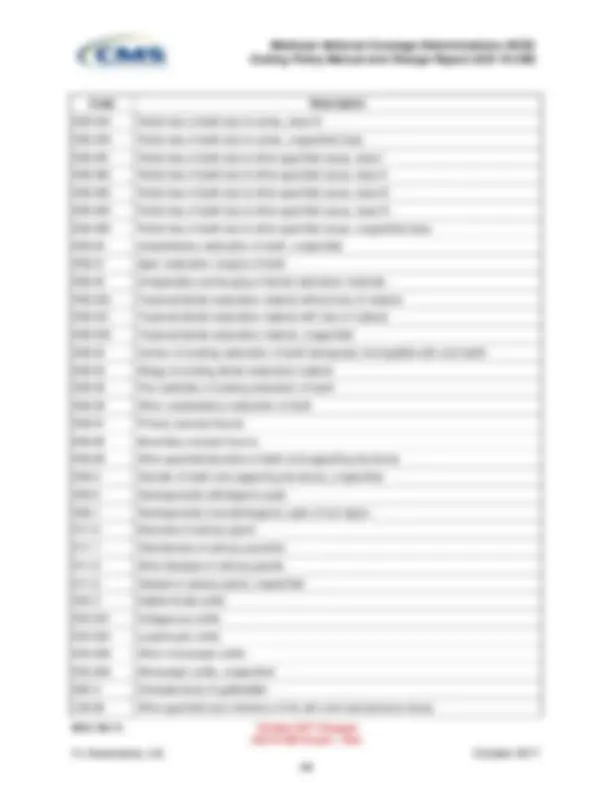
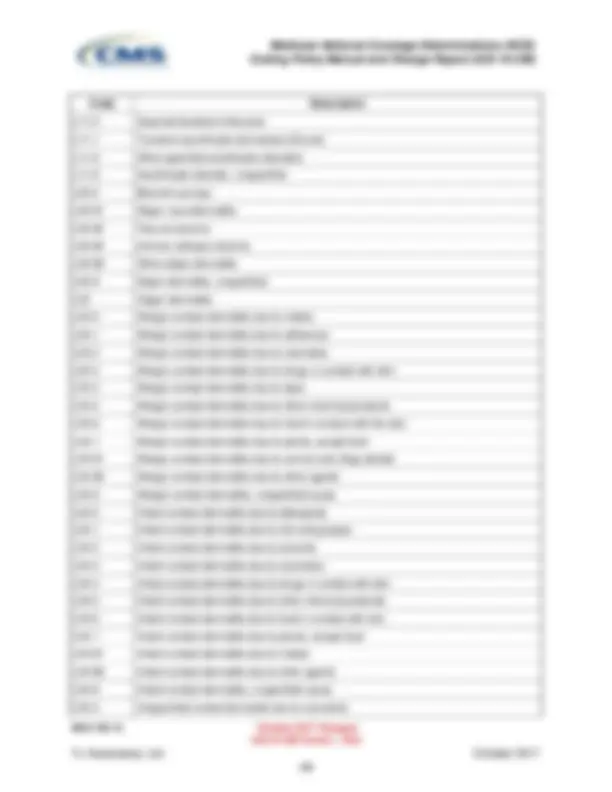
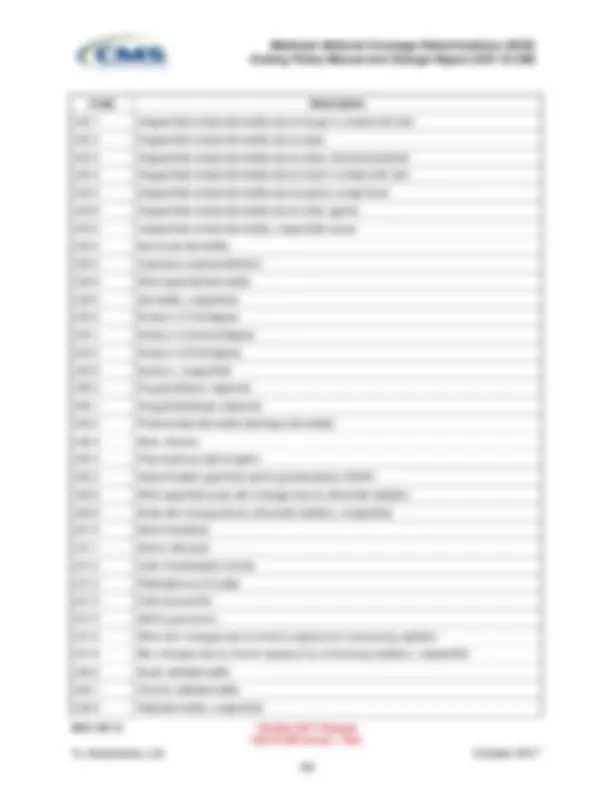
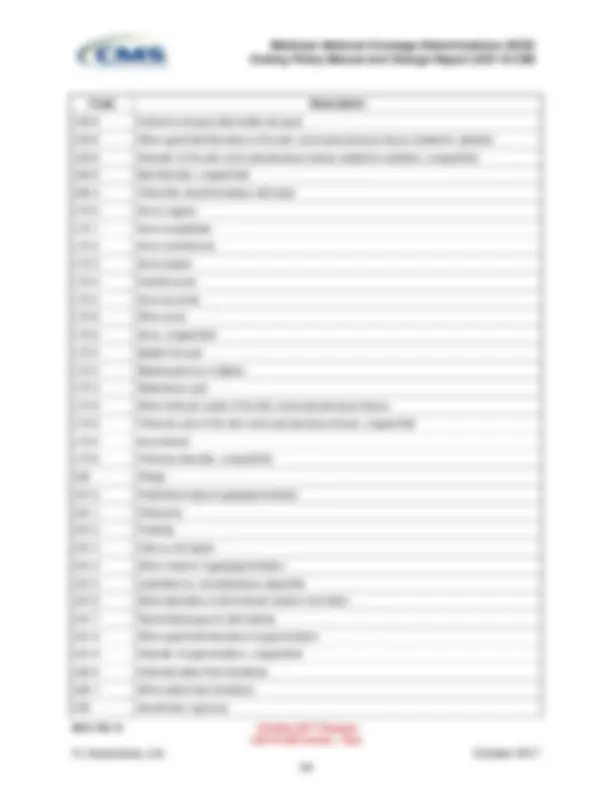

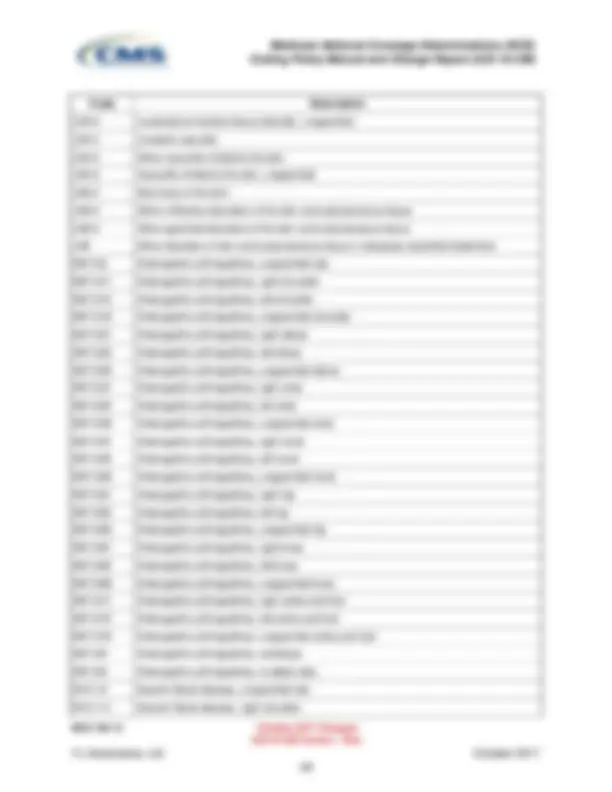
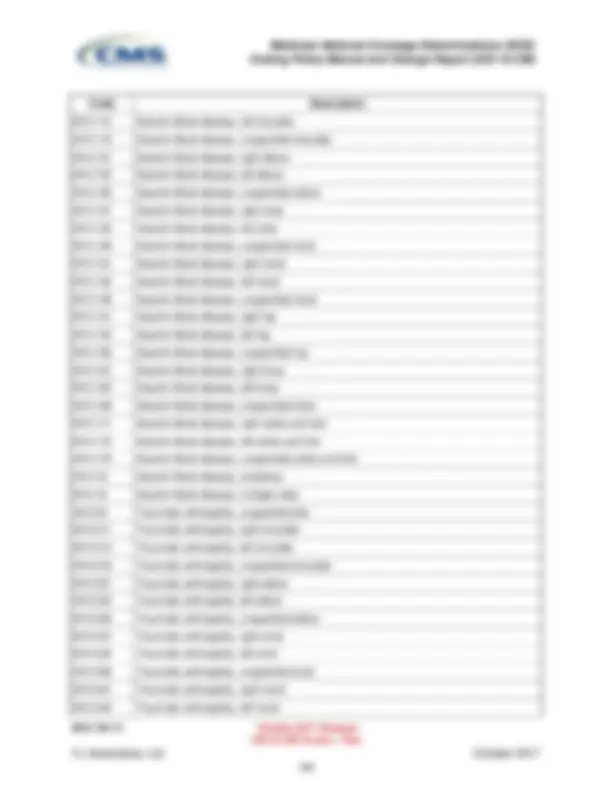
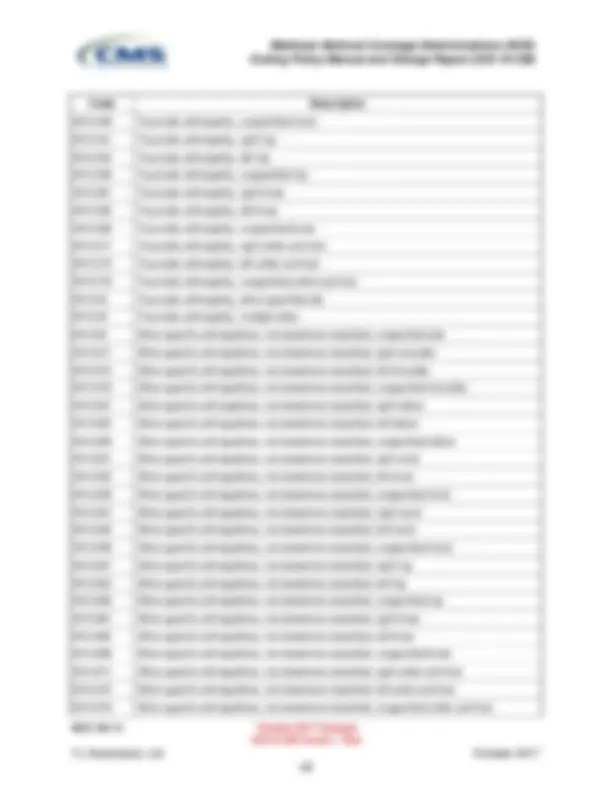
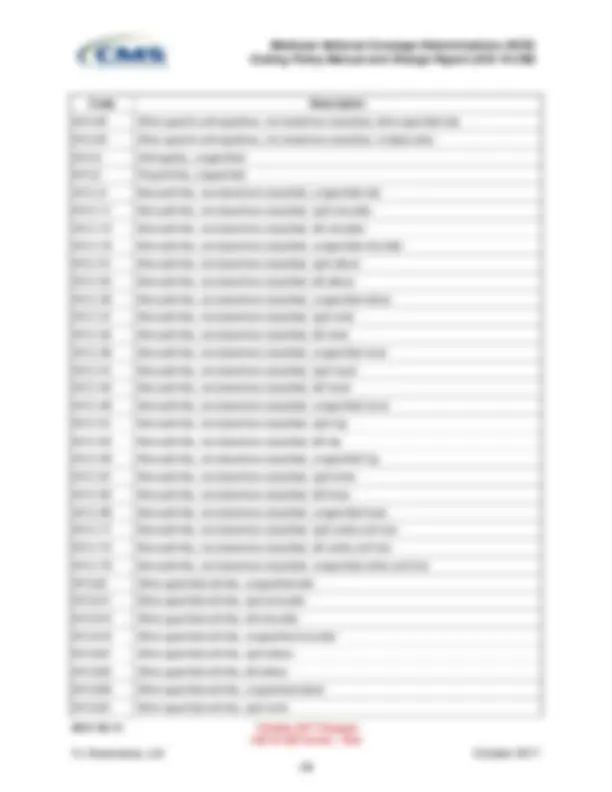
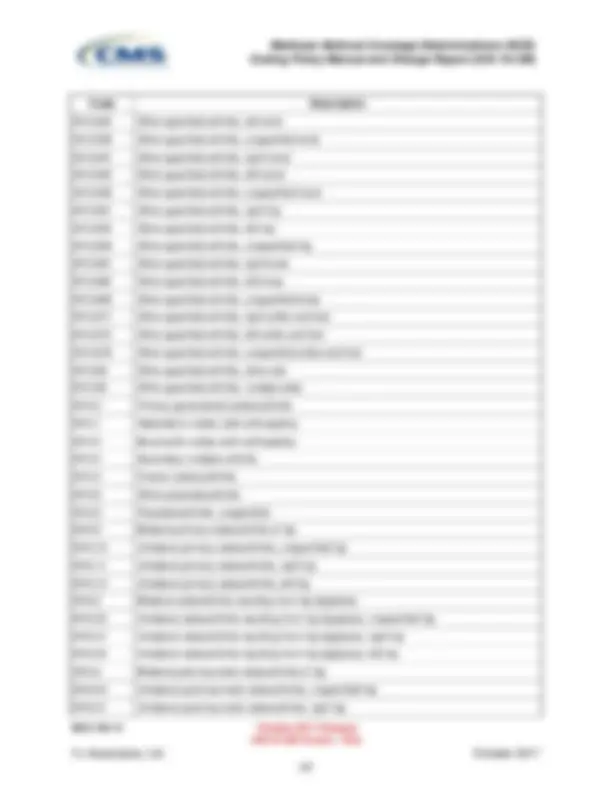
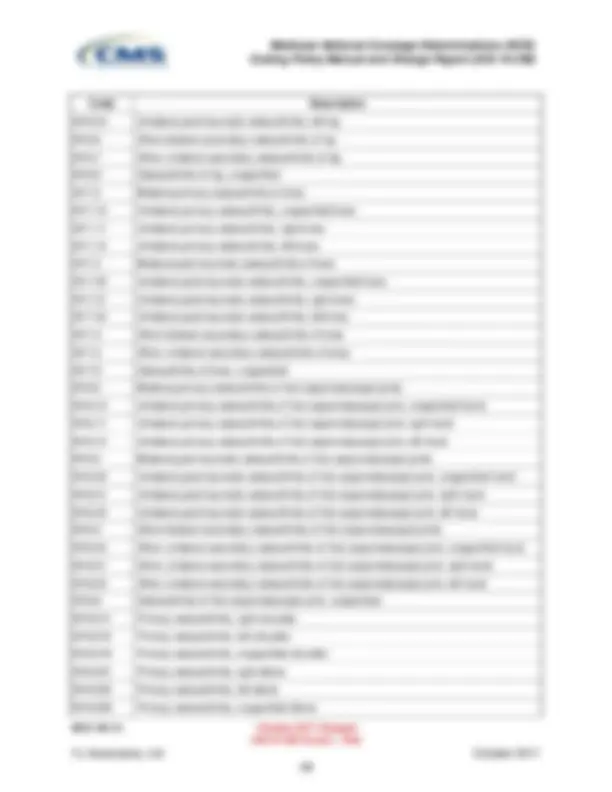
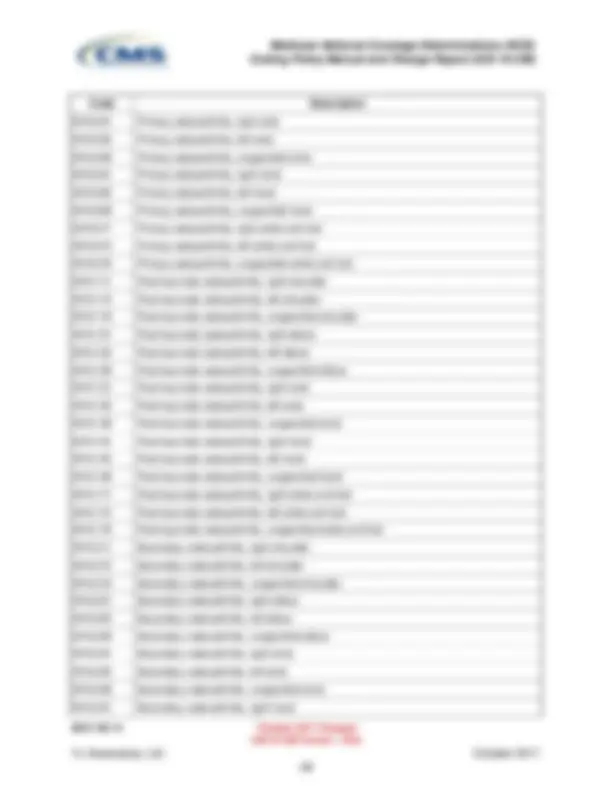
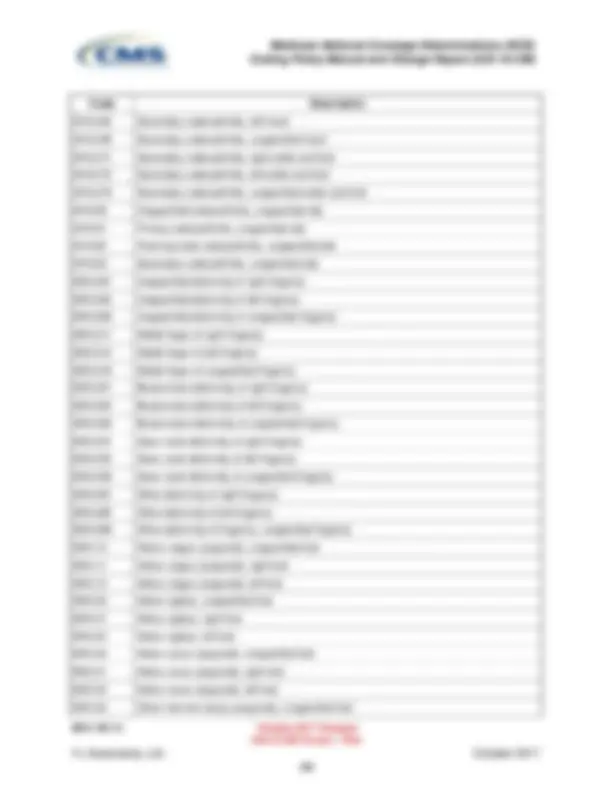
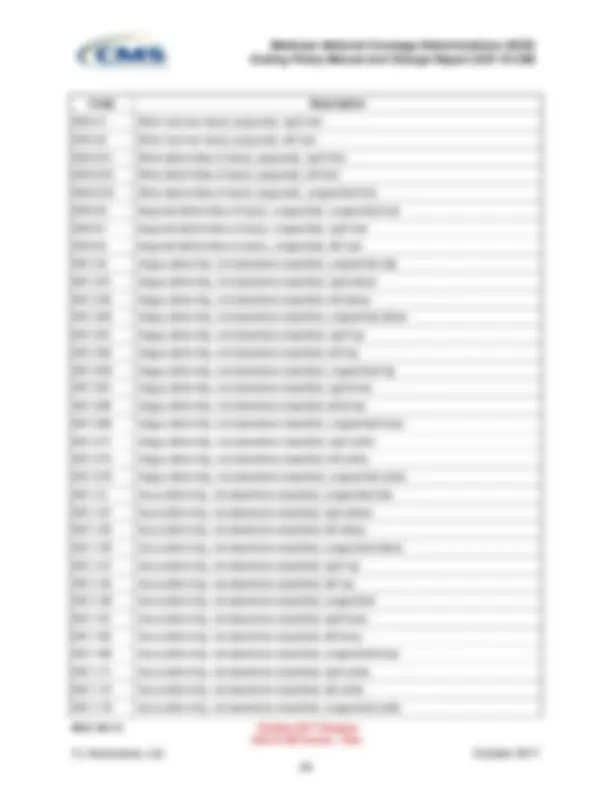
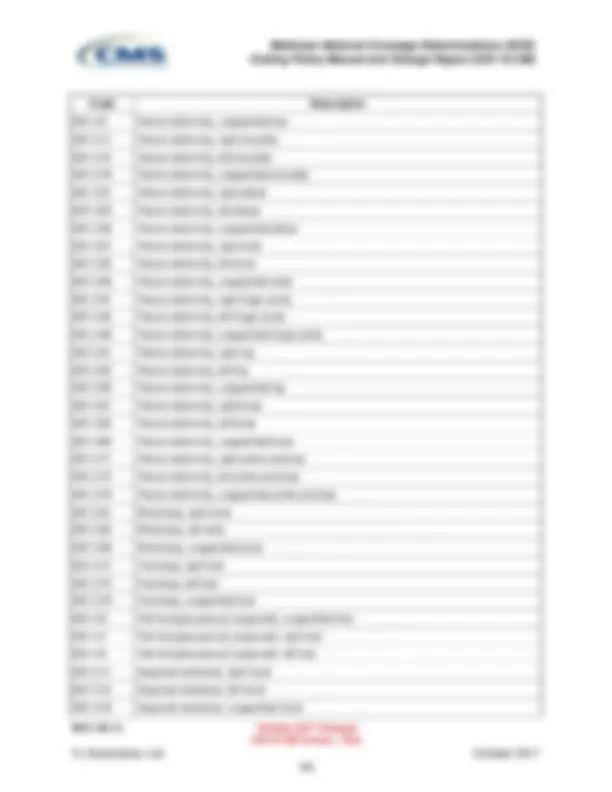
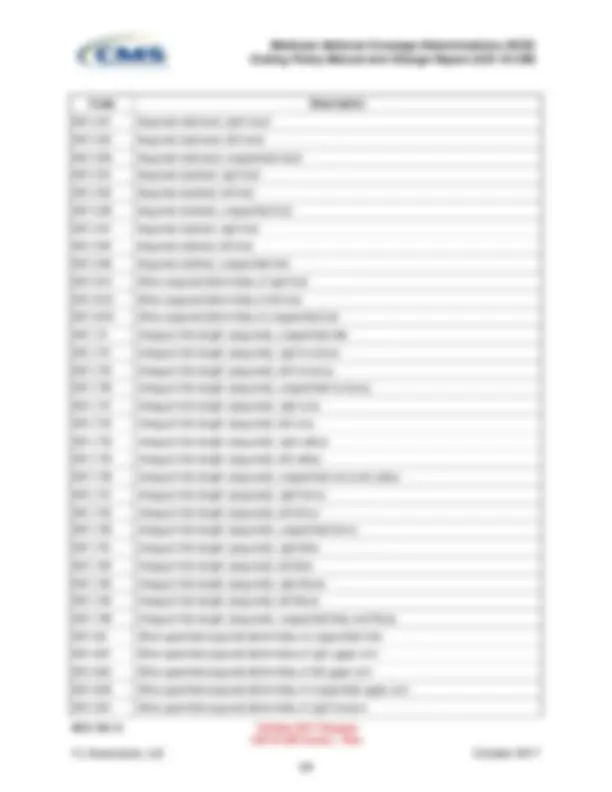
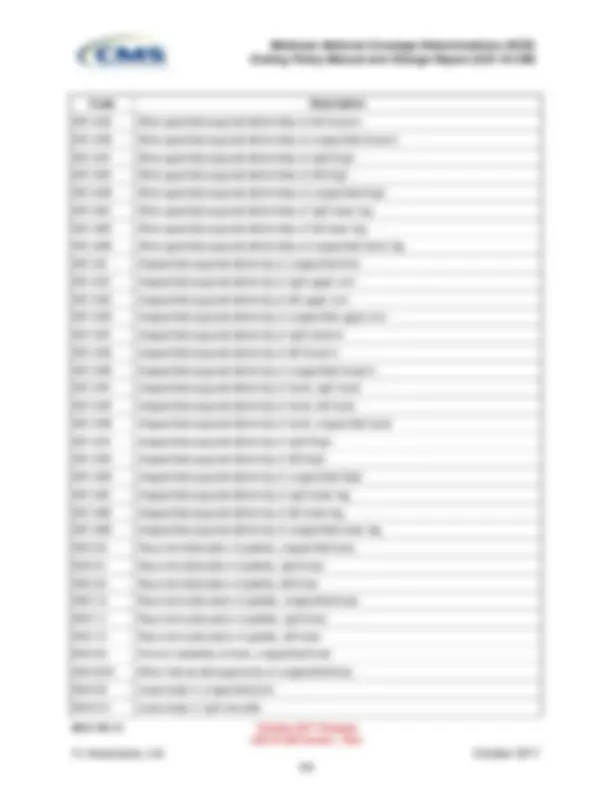
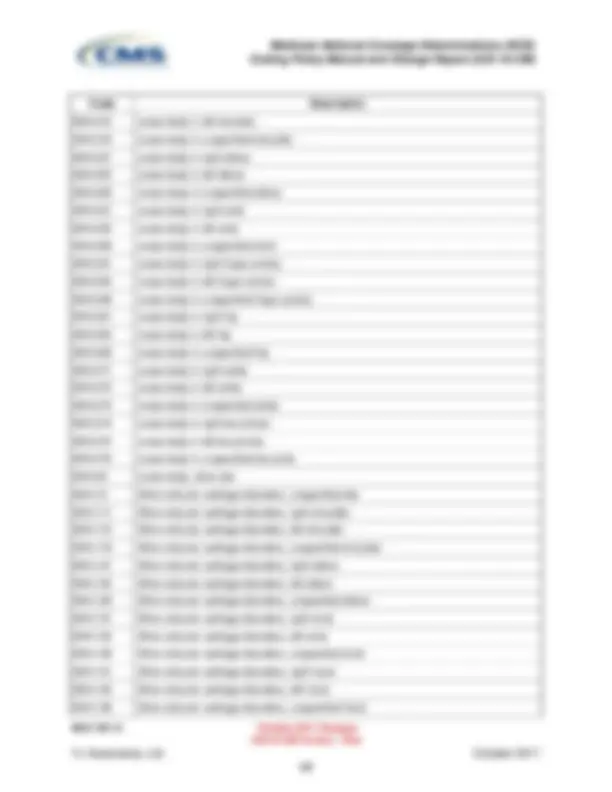
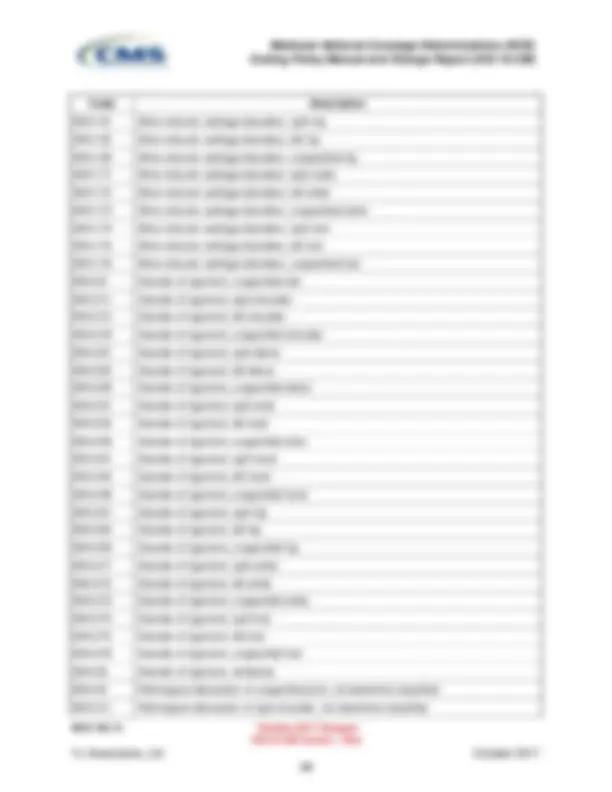
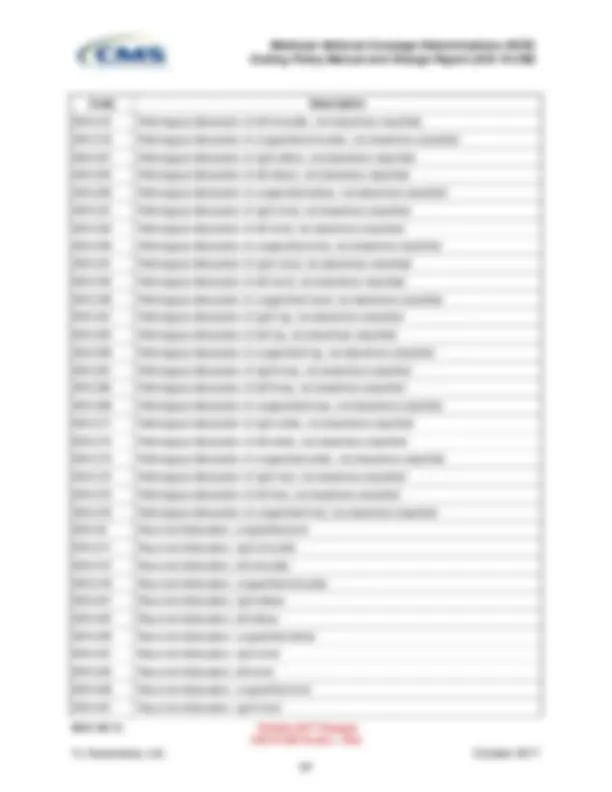
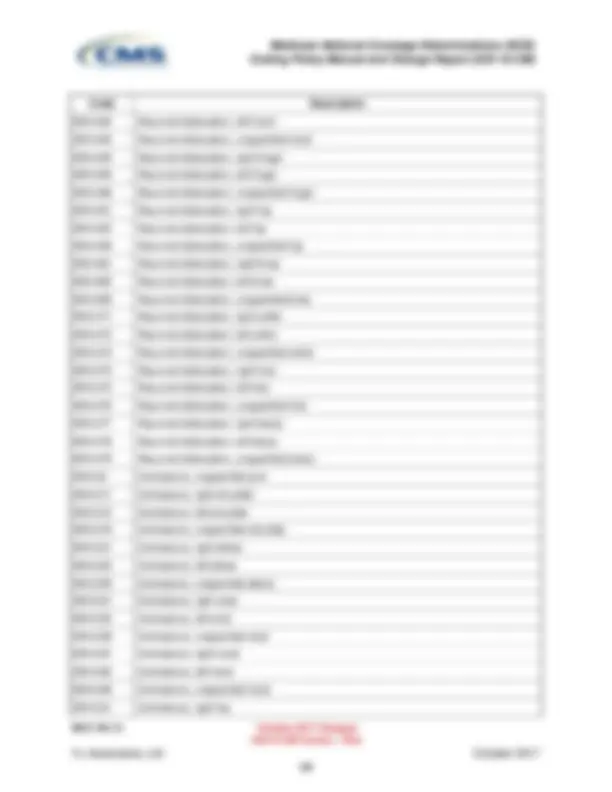
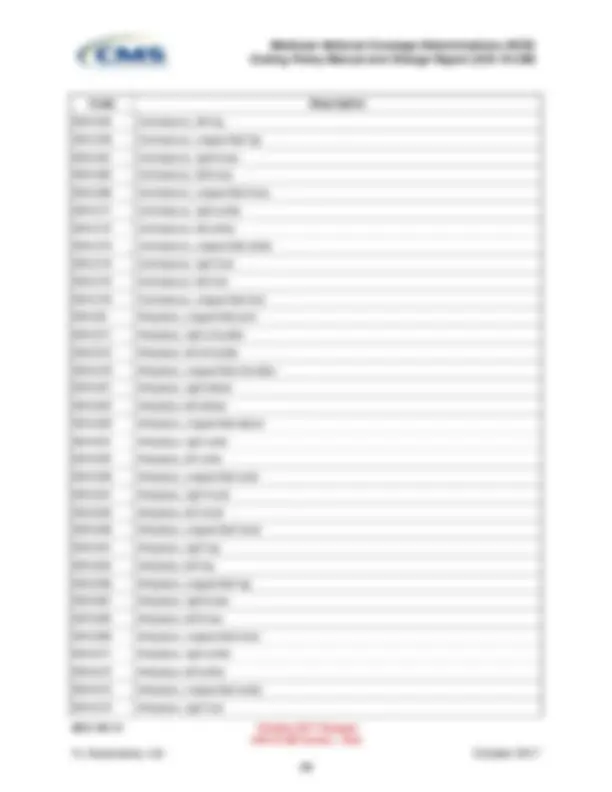
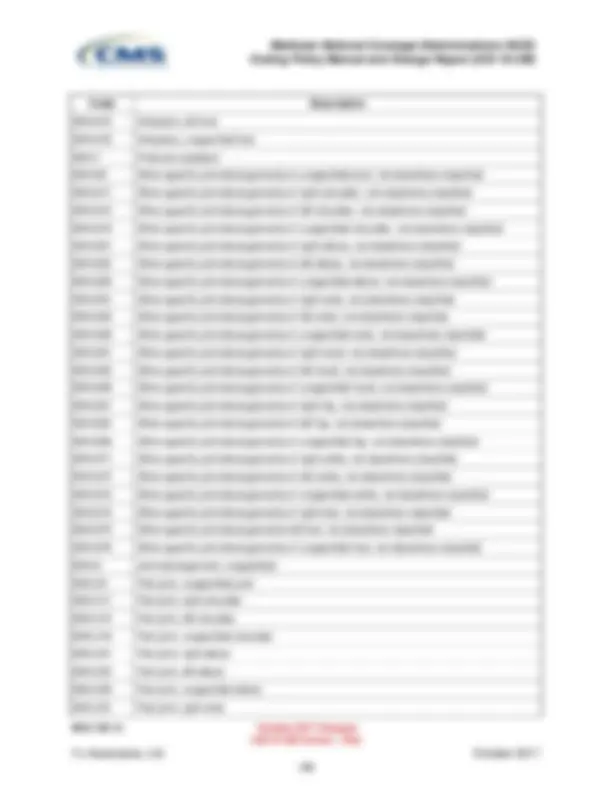
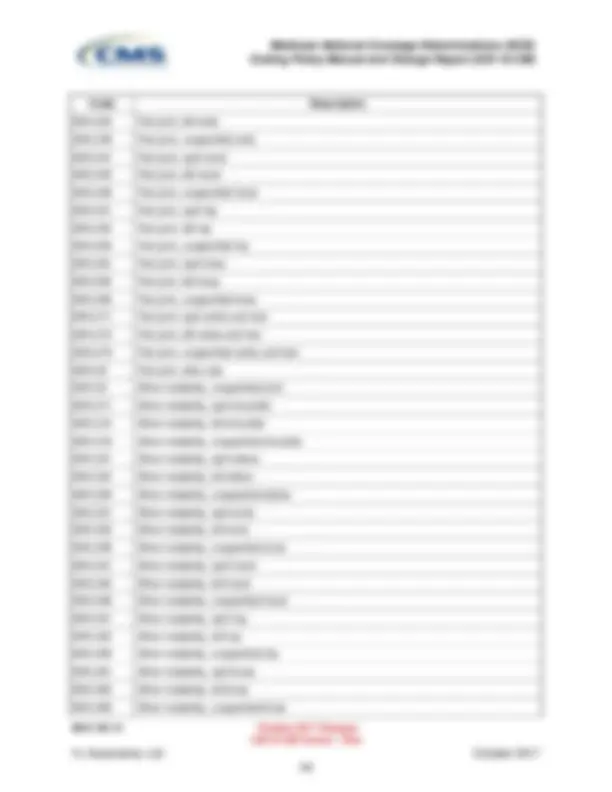
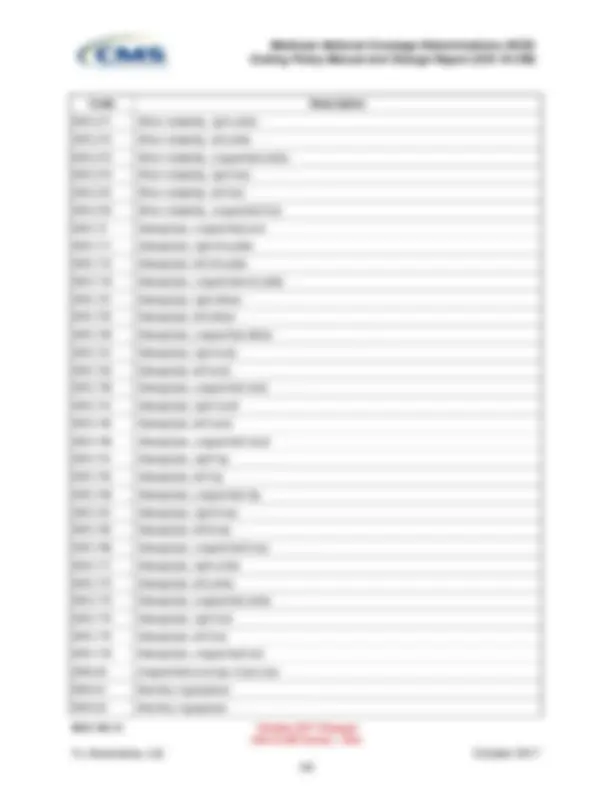
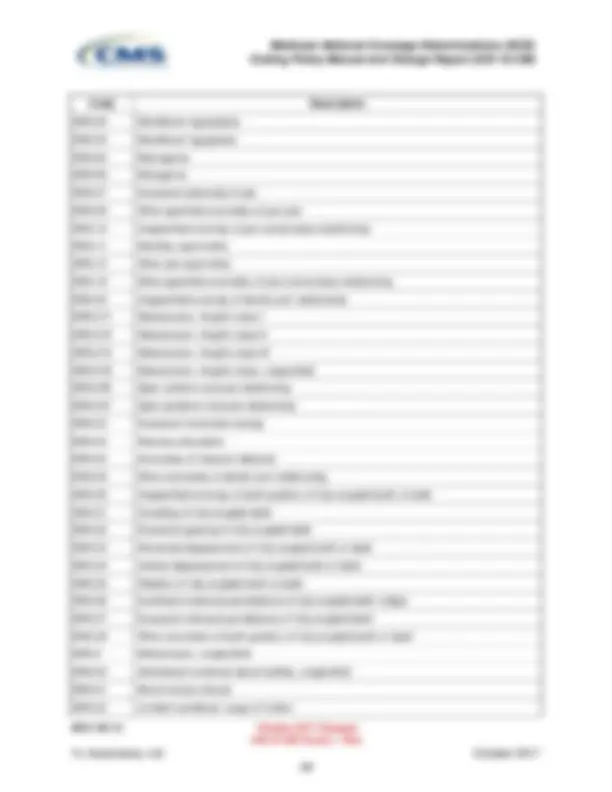
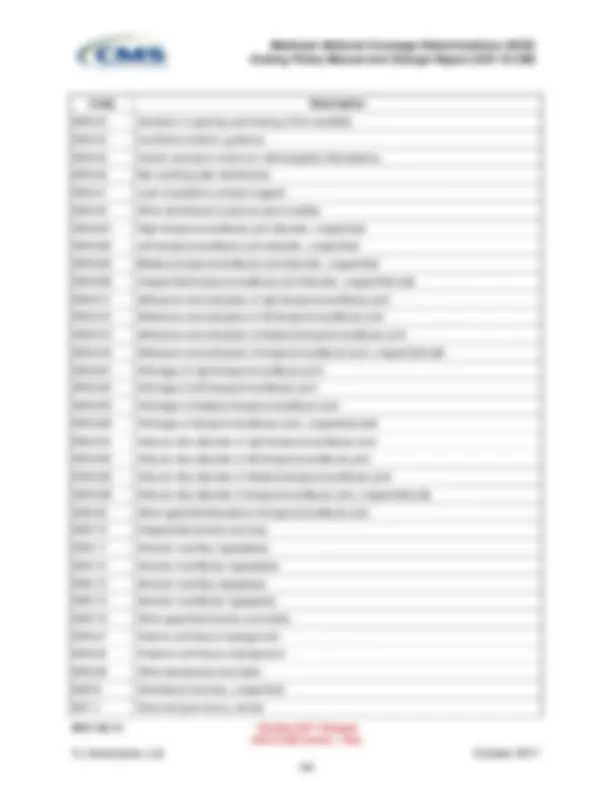
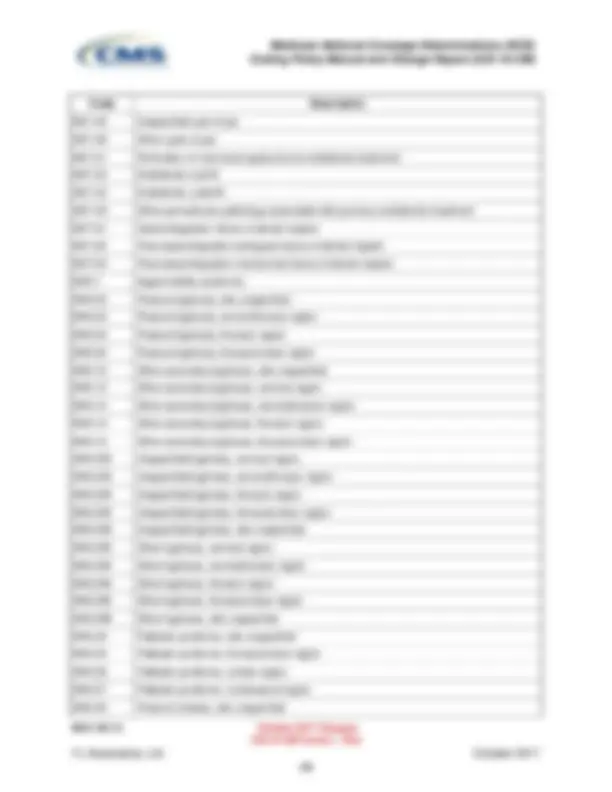
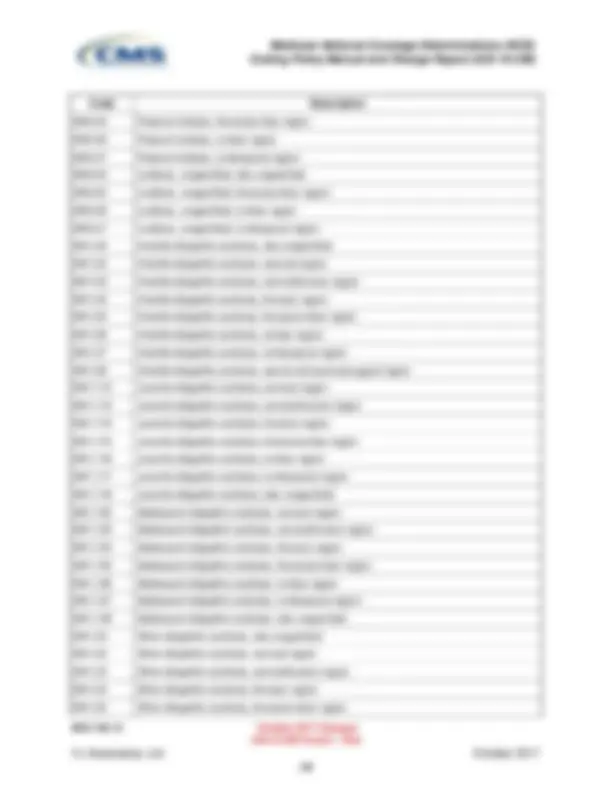
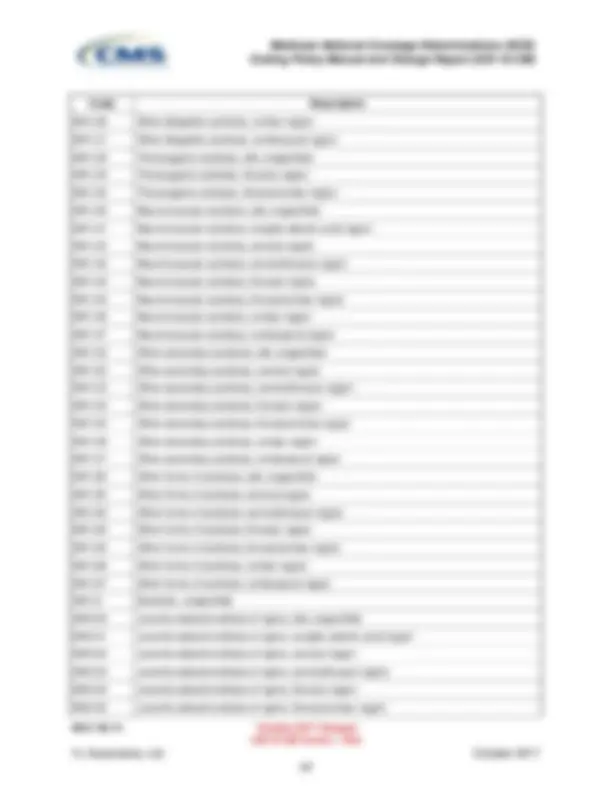
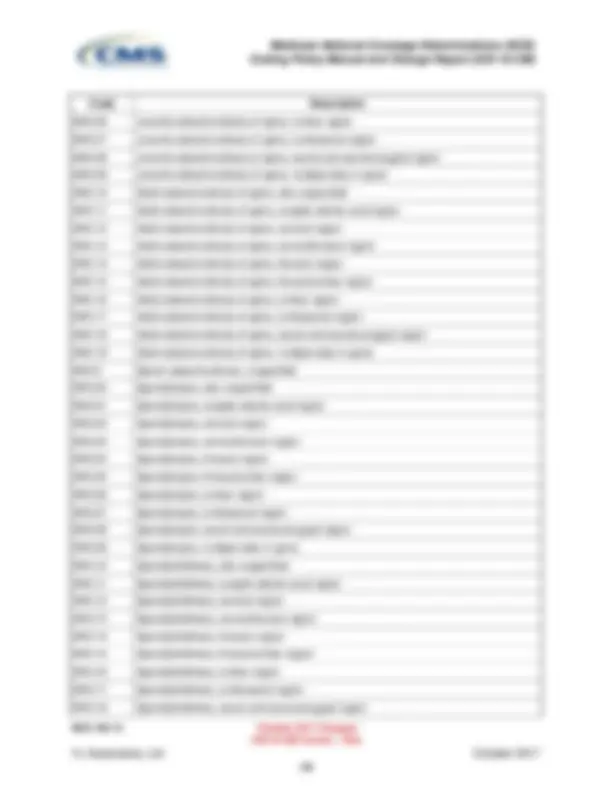
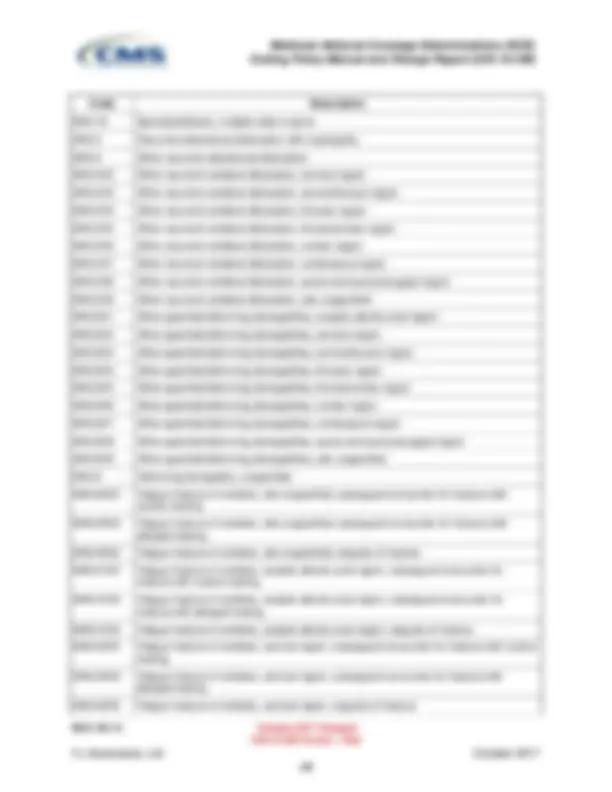
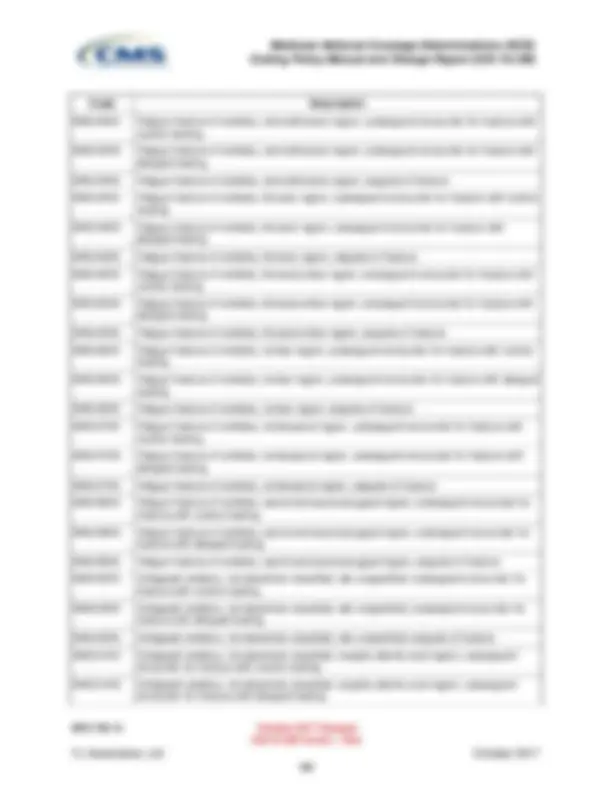
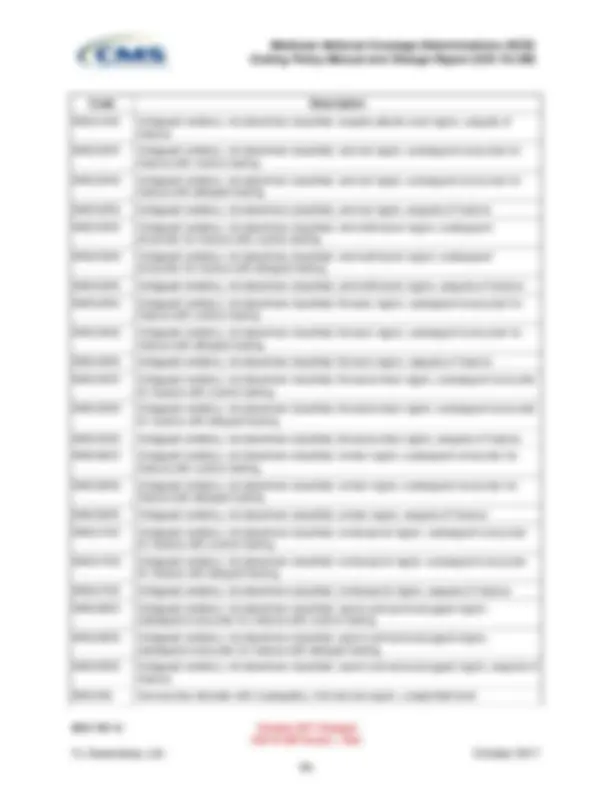
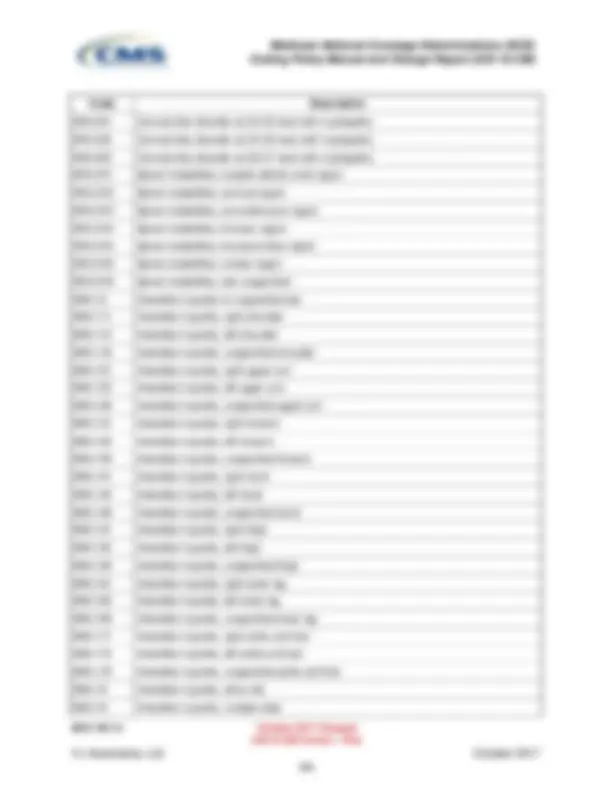
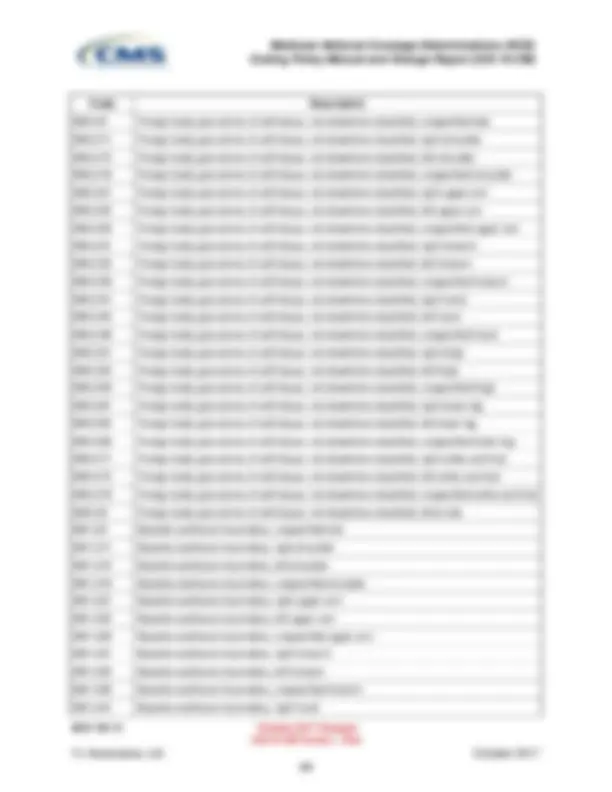
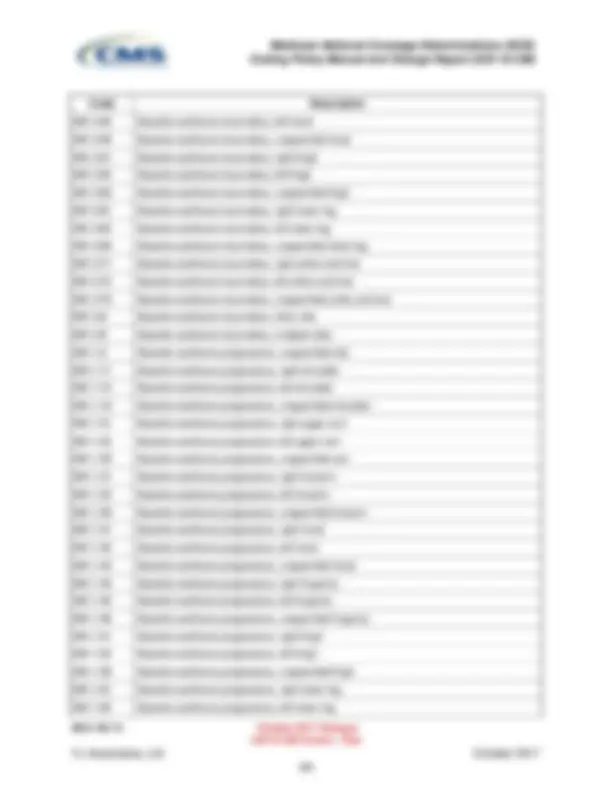
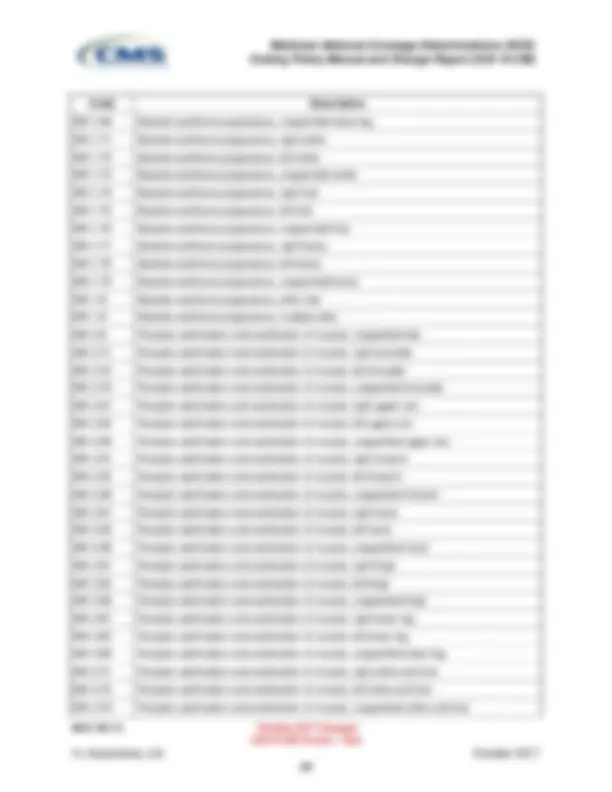
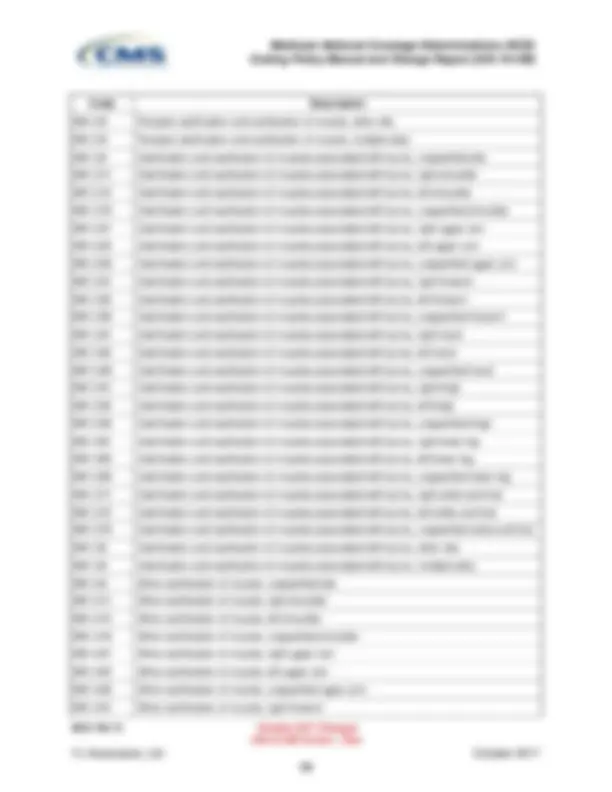
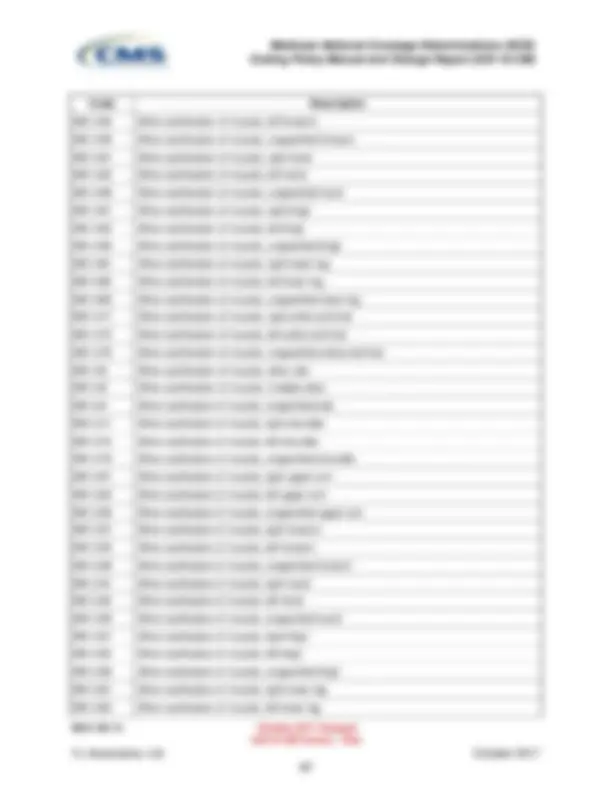
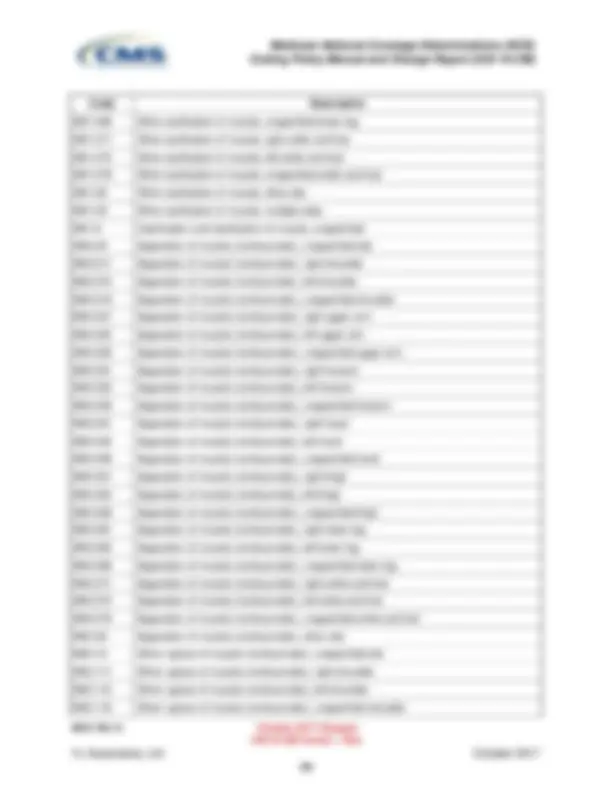
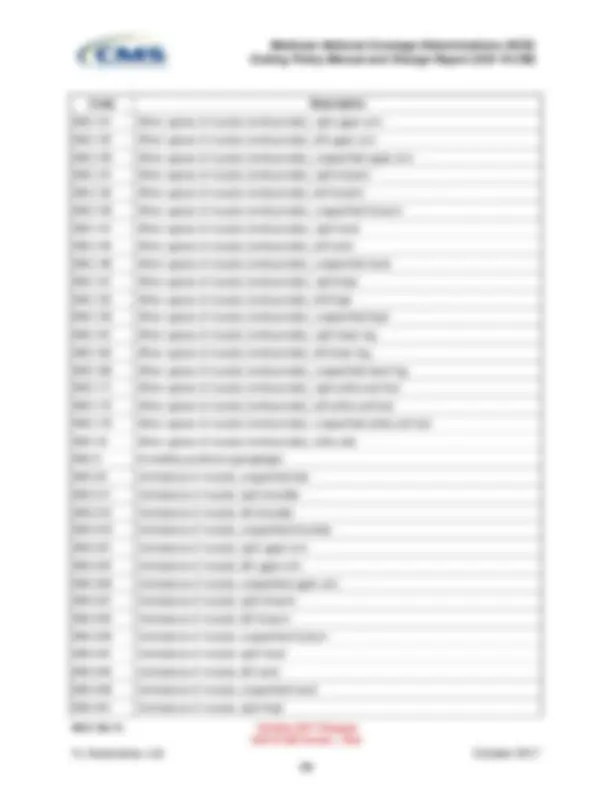
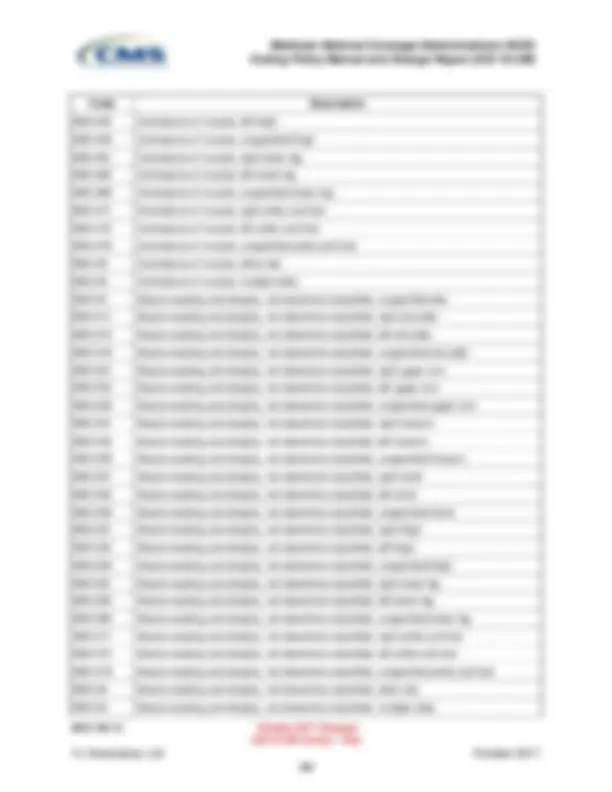
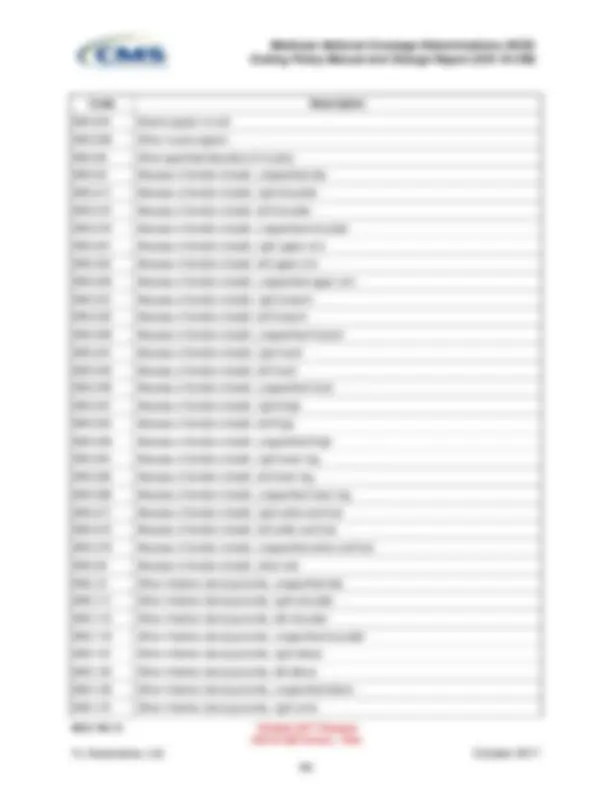
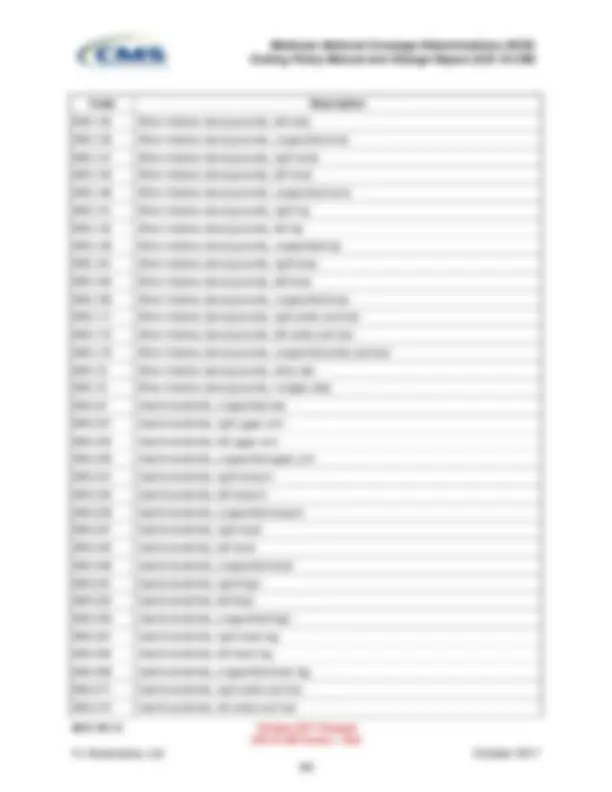
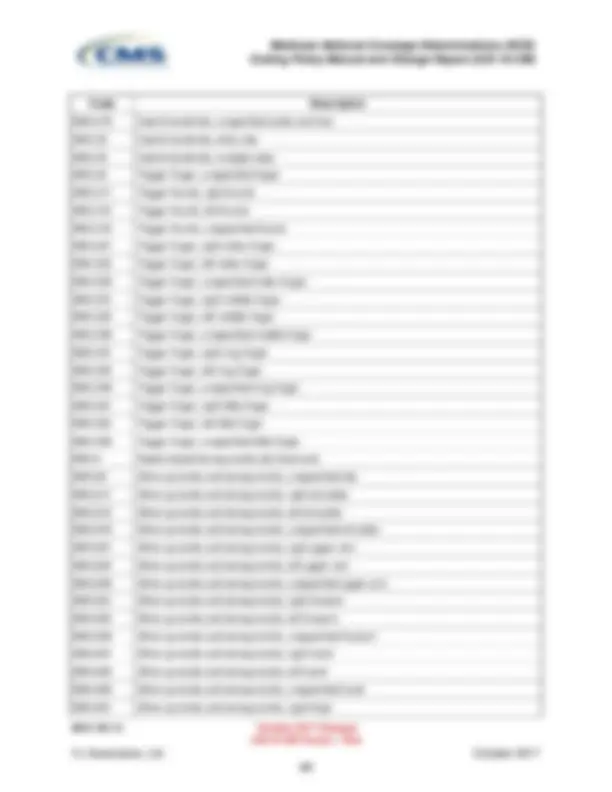
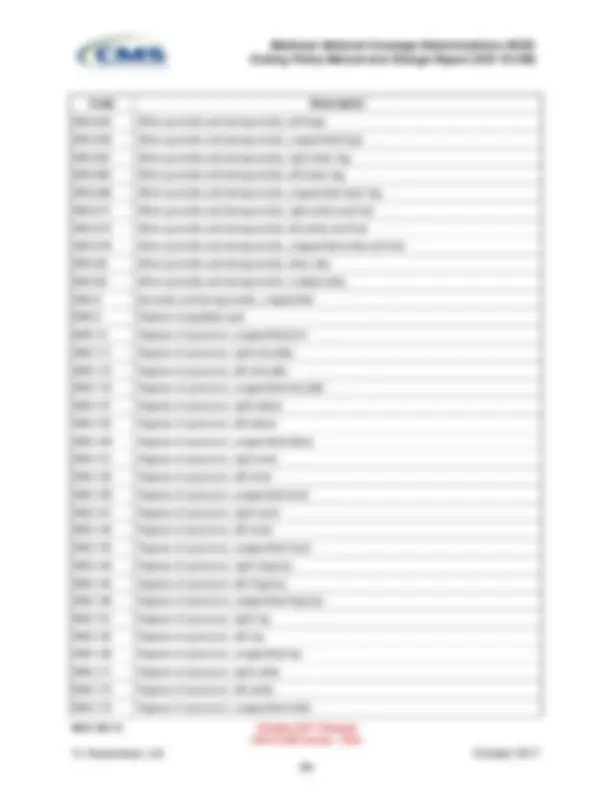
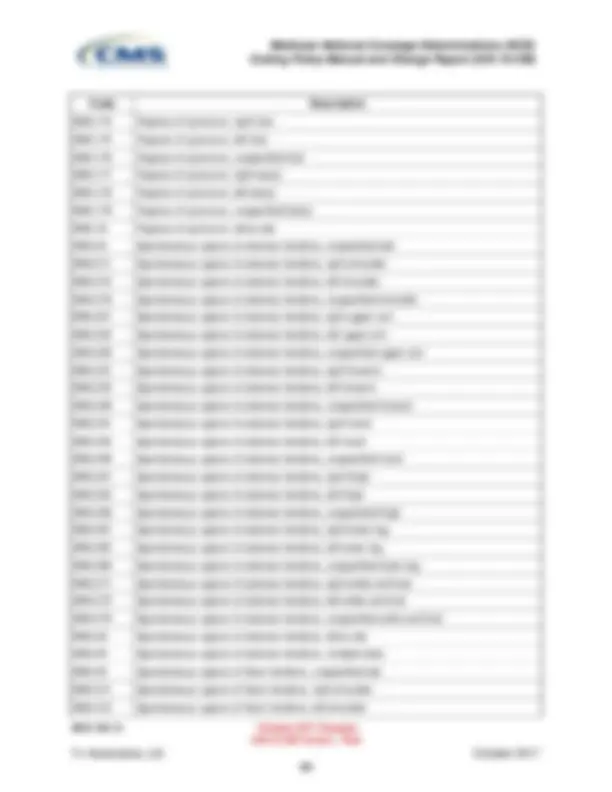
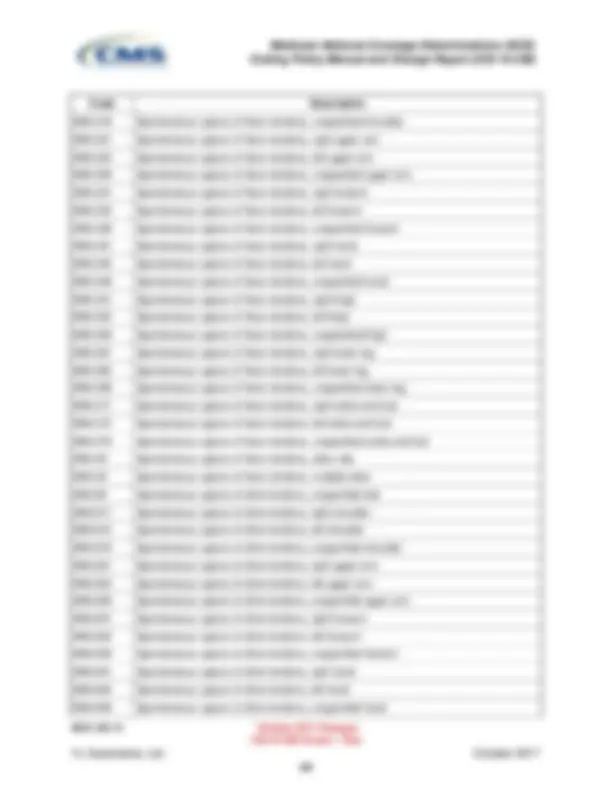
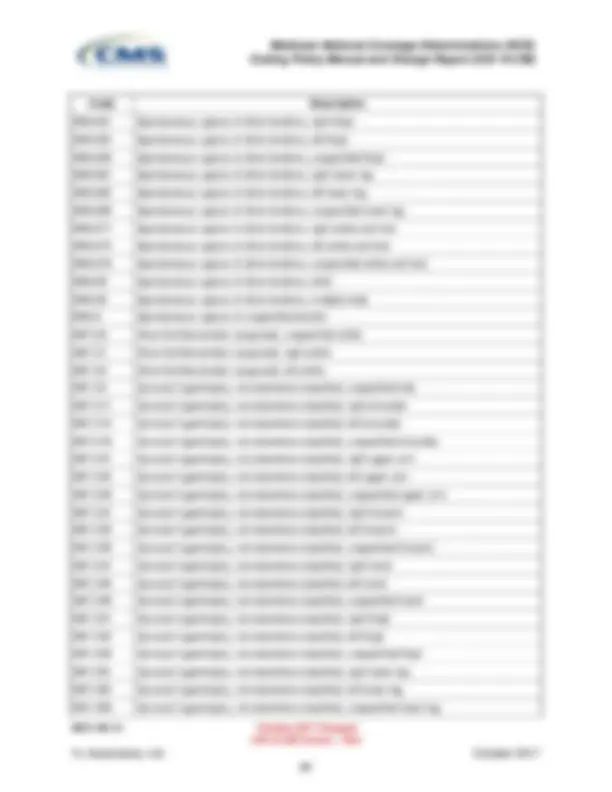
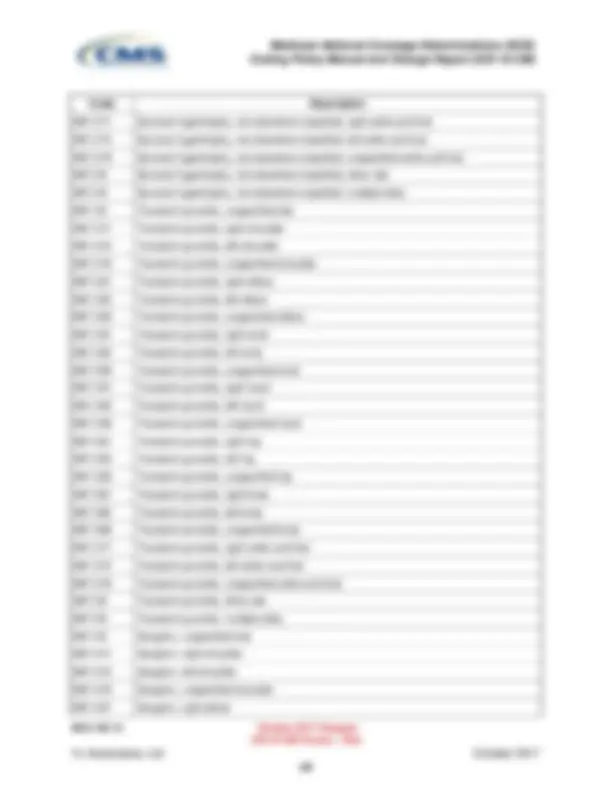
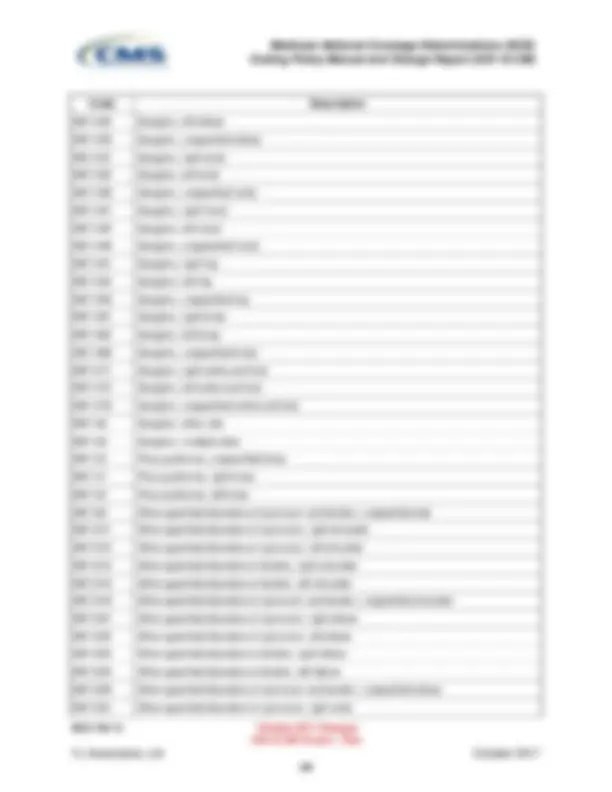
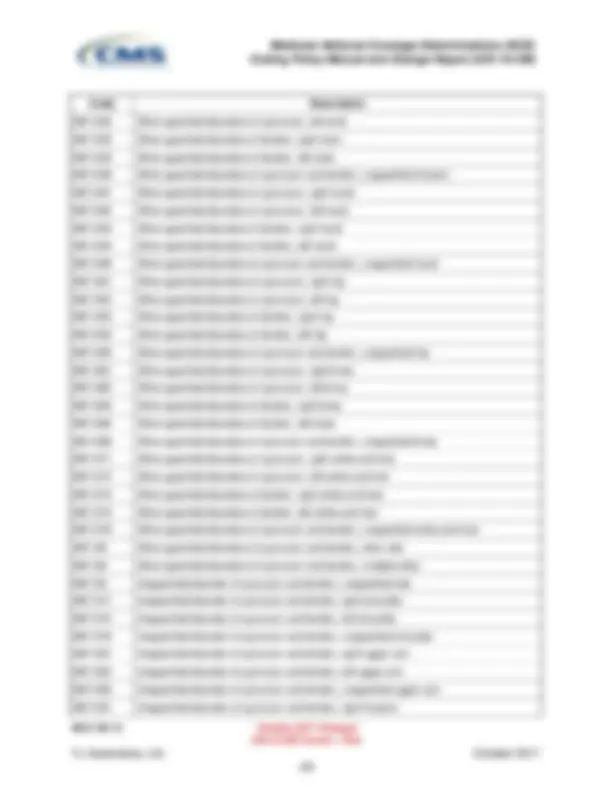
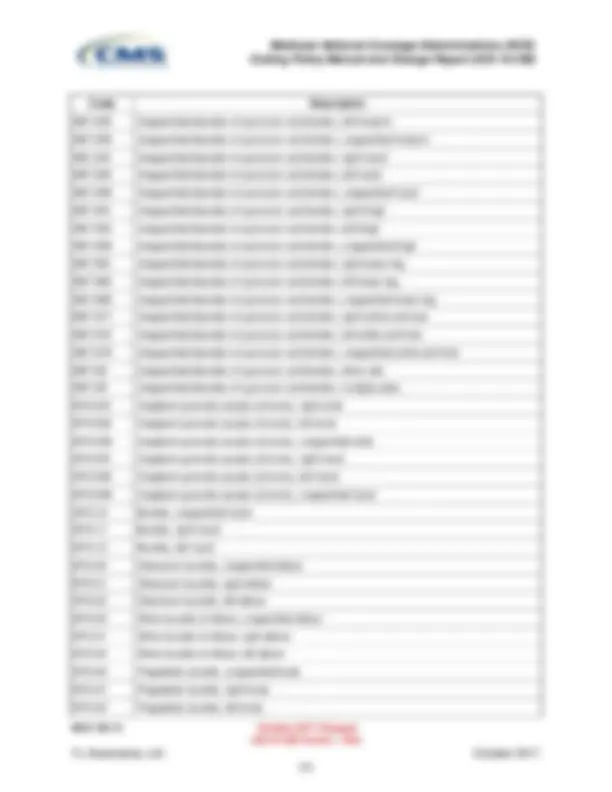
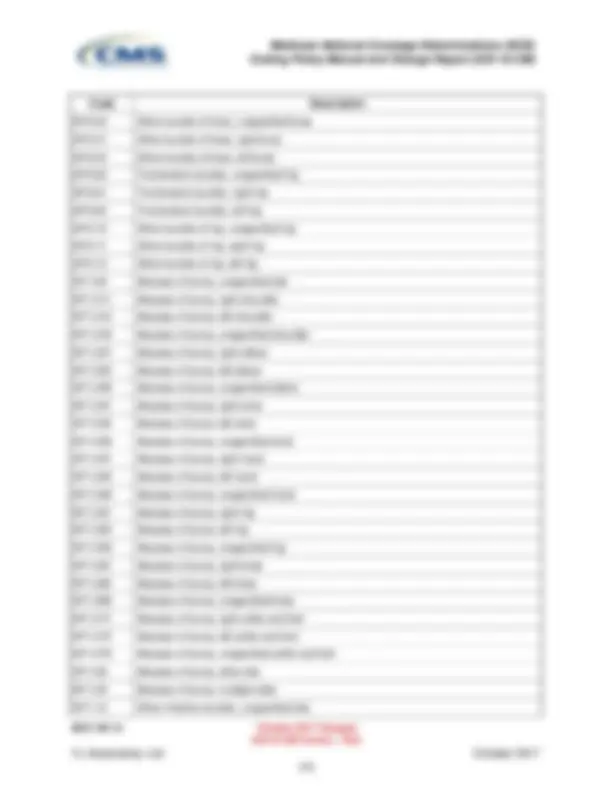
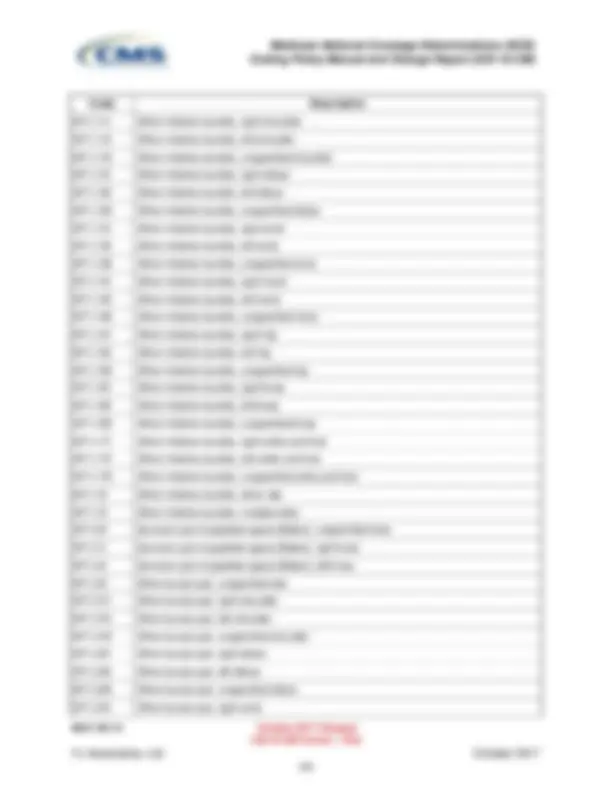
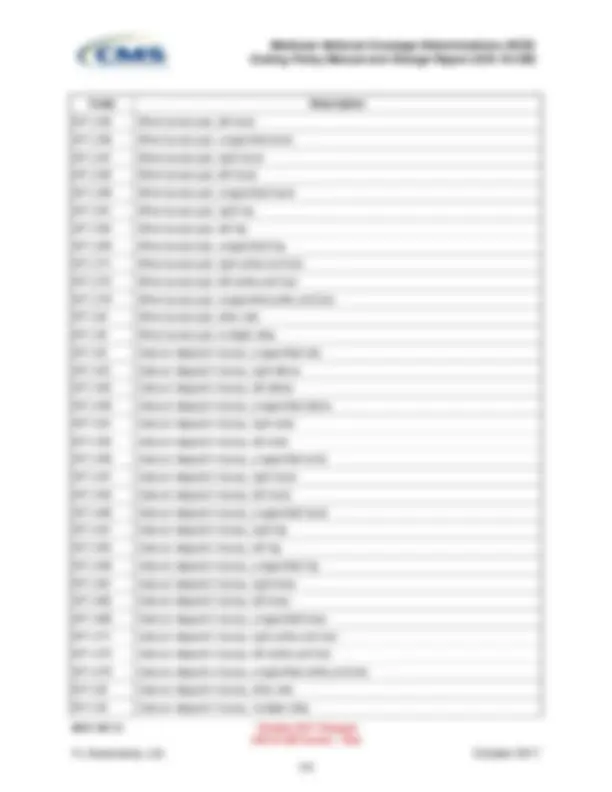
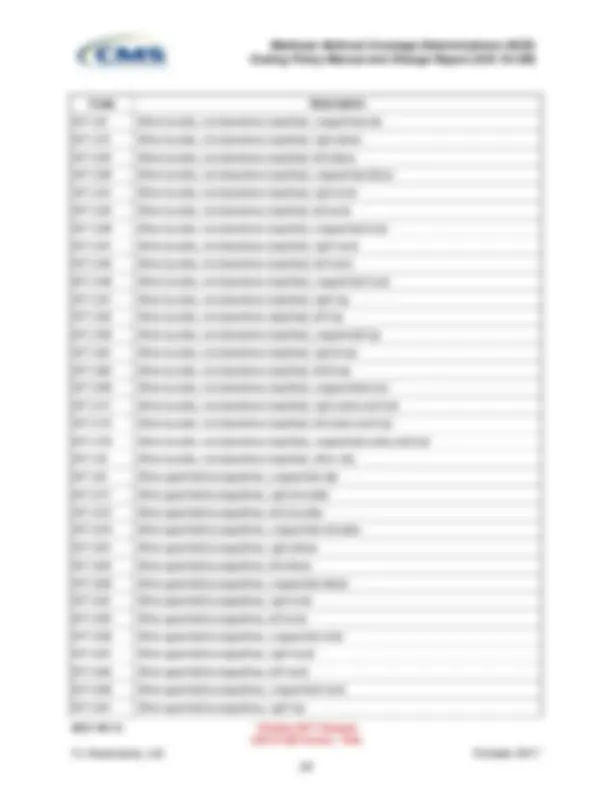

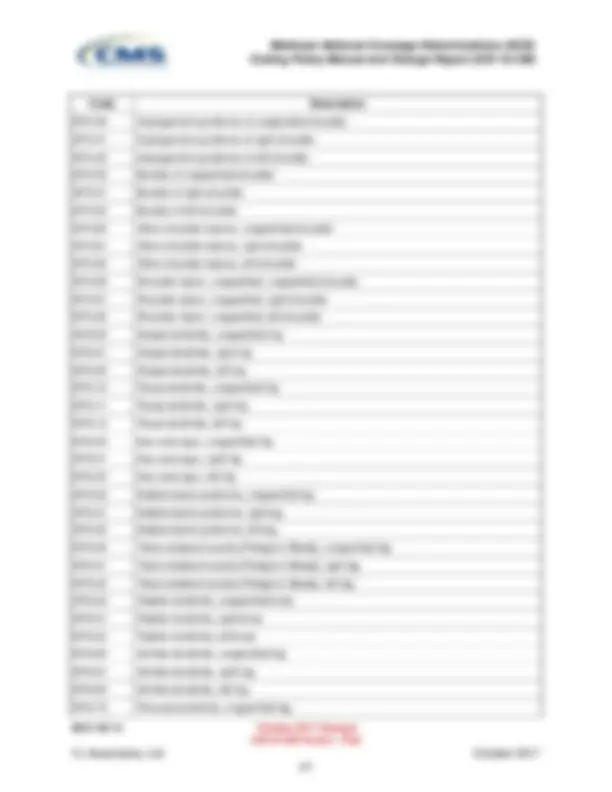
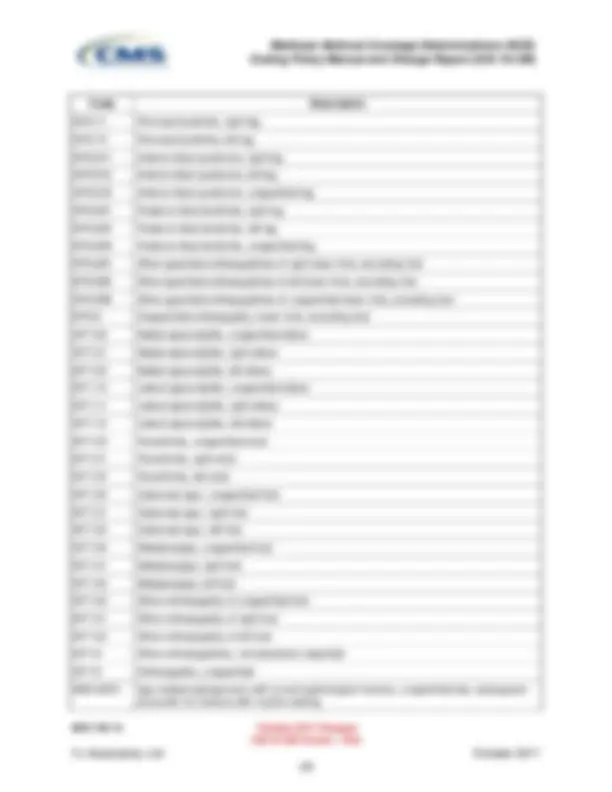
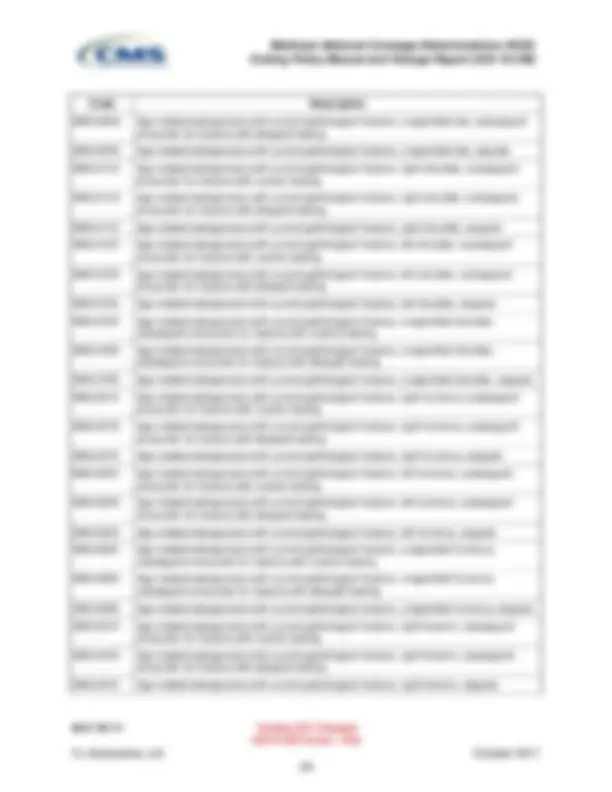
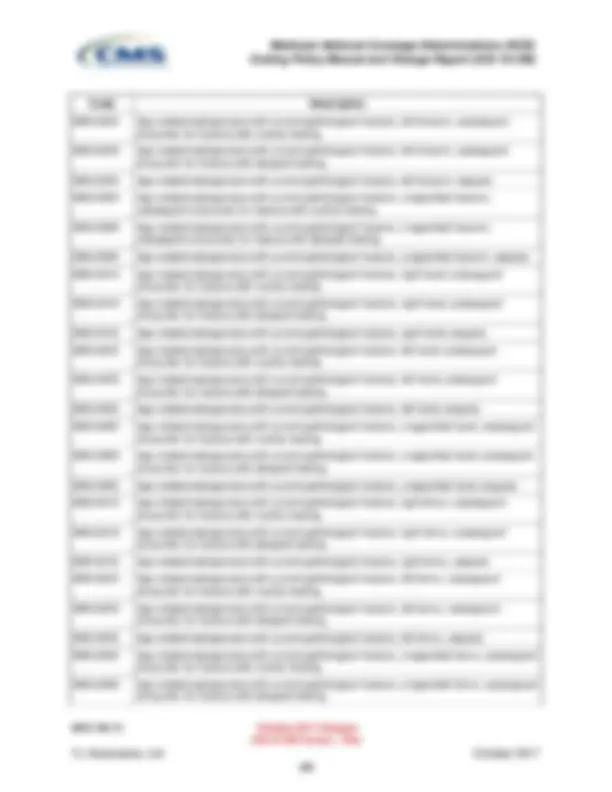


Study with the several resources on Docsity

Earn points by helping other students or get them with a premium plan


Prepare for your exams
Study with the several resources on Docsity

Earn points to download
Earn points by helping other students or get them with a premium plan
Community
Ask the community for help and clear up your study doubts
Discover the best universities in your country according to Docsity users
Free resources
Download our free guides on studying techniques, anxiety management strategies, and thesis advice from Docsity tutors
The complete blood count (CBC) includes a hemogram and differential white blood count. (WBC). The hemogram includes enumeration of red blood cells, white blood ...
Typology: Lecture notes
1 / 797

This page cannot be seen from the preview
Don't miss anything!





























































































*October 2017 Changes ICD-10-CM Version – Red
NCD 190.
85004 Blood count, automated differential white blood cell (WBC) count
85007 Blood count; blood smear, microscopic examination with manual differential WBC count
85008 Blood count; blood smear, microscopic examination without manual differential WBC count 85013 Blood count, Spun microhematocrit 85014 Blood count, hematocrit (Hct) 85018 Blood count, Hemoglobin
85025
Blood count, complete (CBC), automated (Hgb, Hct, RBC, WBC and platelet count) and automated differential WBC count
85027
Blood count, complete (CBC), automated (Hgb, Hct, RBC, WBC and platelet count) 85032 Blood count; manual cell count (erythrocyte, leukocyte, platelet) each
*October 2017 Changes ICD-10-CM Version – Red
NCD 190.
85048 Blood count, leukocyte (WBC), automated 85049 Blood count; platelet, automated
*October 2017 Changes ICD-10-CM Version – Red
NCD 190.
Code Description A18.59 Other tuberculosis of eye A63.0 Anogenital (venereal) warts B07.0 Plantar wart B07.8 Other viral warts B07.9 Viral wart, unspecified D00.00 Carcinoma in situ of oral cavity, unspecified site D00.01 Carcinoma in situ of labial mucosa and vermilion border D00.02 Carcinoma in situ of buccal mucosa D00.03 Carcinoma in situ of gingiva and edentulous alveolar ridge D00.04 Carcinoma in situ of soft palate D00.05 Carcinoma in situ of hard palate D00.06 Carcinoma in situ of floor of mouth D00.07 Carcinoma in situ of tongue D00.08 Carcinoma in situ of pharynx D04.0 Carcinoma in situ of skin of lip D04.10 Carcinoma in situ of skin of unspecified eyelid, including canthus D04.11 Carcinoma in situ of skin of right eyelid, including canthus D04.12 Carcinoma in situ of skin of left eyelid, including canthus D04.20 Carcinoma in situ of skin of unspecified ear and external auricular canal D04.21 Carcinoma in situ of skin of right ear and external auricular canal D04.22 Carcinoma in situ of skin of left ear and external auricular canal D04.30 Carcinoma in situ of skin of unspecified part of face
*October 2017 Changes ICD-10-CM Version – Red
NCD 190.
Code Description D04.39 Carcinoma in situ of skin of other parts of face D04.4 Carcinoma in situ of skin of scalp and neck D04.5 Carcinoma in situ of skin of trunk D04.60 Carcinoma in situ of skin of unspecified upper limb, including shoulder D04.61 Carcinoma in situ of skin of right upper limb, including shoulder D04.62 Carcinoma in situ of skin of left upper limb, including shoulder D04.70 Carcinoma in situ of skin of unspecified lower limb, including hip D04.71 Carcinoma in situ of skin of right lower limb, including hip D04.72 Carcinoma in situ of skin of left lower limb, including hip D04.8 Carcinoma in situ of skin of other sites D04.9 Carcinoma in situ of skin, unspecified D10.0 Benign neoplasm of lip D10.1 Benign neoplasm of tongue D10.2 Benign neoplasm of floor of mouth D10.30 Benign neoplasm of unspecified part of mouth D10.39 Benign neoplasm of other parts of mouth D10.4 Benign neoplasm of tonsil D10.5 Benign neoplasm of other parts of oropharynx D10.6 Benign neoplasm of nasopharynx D10.7 Benign neoplasm of hypopharynx D10.9 Benign neoplasm of pharynx, unspecified D11.0 Benign neoplasm of parotid gland D11.7 Benign neoplasm of other major salivary glands D11.9 Benign neoplasm of major salivary gland, unspecified D17.0 Benign lipomatous neoplasm of skin and subcutaneous tissue of head, face and neck D22.0 Melanocytic nevi of lip D22.10 Melanocytic nevi of unspecified eyelid, including canthus D22.11 Melanocytic nevi of right eyelid, including canthus D22.12 Melanocytic nevi of left eyelid, including canthus D22.20 Melanocytic nevi of unspecified ear and external auricular canal D22.21 Melanocytic nevi of right ear and external auricular canal D22.22 Melanocytic nevi of left ear and external auricular canal D22.30 Melanocytic nevi of unspecified part of face D22.39 Melanocytic nevi of other parts of face
*October 2017 Changes ICD-10-CM Version – Red
NCD 190.
Code Description D29.22 Benign neoplasm of left testis D29.30 Benign neoplasm of unspecified epididymis D29.31 Benign neoplasm of right epididymis D29.32 Benign neoplasm of left epididymis D29.4 Benign neoplasm of scrotum D29.8 Benign neoplasm of other specified male genital organs D29.9 Benign neoplasm of male genital organ, unspecified D31.40 Benign neoplasm of unspecified ciliary body D31.41 Benign neoplasm of right ciliary body D31.42 Benign neoplasm of left ciliary body D48.1 Neoplasm of uncertain behavior of connective and other soft tissue E08.36 Diabetes mellitus due to underlying condition with diabetic cataract E08.51 Diabetes mellitus due to underlying condition with diabetic peripheral angiopathy without gangrene E08.52 Diabetes mellitus due to underlying condition with diabetic peripheral angiopathy with gangrene E08.618 Diabetes mellitus due to underlying condition with other diabetic arthropathy E09.36 Drug or chemical induced diabetes mellitus with diabetic cataract E09.51 Drug or chemical induced diabetes mellitus with diabetic peripheral angiopathy without gangrene E09.52 Drug or chemical induced diabetes mellitus with diabetic peripheral angiopathy with gangrene E09.618 Drug or chemical induced diabetes mellitus with other diabetic arthropathy E10.36 Type 1 diabetes mellitus with diabetic cataract E10.51 Type 1 diabetes mellitus with diabetic peripheral angiopathy without gangrene E10.52 Type 1 diabetes mellitus with diabetic peripheral angiopathy with gangrene E10.618 Type 1 diabetes mellitus with other diabetic arthropathy E11.36 Type 2 diabetes mellitus with diabetic cataract E11.51 Type 2 diabetes mellitus with diabetic peripheral angiopathy without gangrene E11.52 Type 2 diabetes mellitus with diabetic peripheral angiopathy with gangrene E11.618 Type 2 diabetes mellitus with other diabetic arthropathy E13.36 Other specified diabetes mellitus with diabetic cataract E13.51 Other specified diabetes mellitus with diabetic peripheral angiopathy without gangrene E13.52 Other specified diabetes mellitus with diabetic peripheral angiopathy with gangrene E13.618 Other specified diabetes mellitus with other diabetic arthropathy
*October 2017 Changes ICD-10-CM Version – Red
NCD 190.
Code Description E23.0 Hypopituitarism F21 Schizotypal disorder F34.0 Cyclothymic disorder F34.1 Dysthymic disorder F41.0 Panic disorder [episodic paroxysmal anxiety] without agoraphobia F41.1 Generalized anxiety disorder F41.3 Other mixed anxiety disorders F41.8 Other specified anxiety disorders F41.9 Anxiety disorder, unspecified F45.41 Pain disorder exclusively related to psychological factors F45.42 Pain disorder with related psychological factors F48.9 Nonpsychotic mental disorder, unspecified F52.0 Hypoactive sexual desire disorder F52.1 Sexual aversion disorder F52.21 Male erectile disorder F52.22 Female sexual arousal disorder F52.31 Female orgasmic disorder F52.32 Male orgasmic disorder F52.4 Premature ejaculation F52.6 Dyspareunia not due to a substance or known physiological condition F52.8 Other sexual dysfunction not due to a substance or known physiological condition F52.9 Unspecified sexual dysfunction not due to a substance or known physiological condition F60.0 Paranoid personality disorder F60.1 Schizoid personality disorder F60.2 Antisocial personality disorder F60.3 Borderline personality disorder F60.4 Histrionic personality disorder F60.5 Obsessive-compulsive personality disorder F60.6 Avoidant personality disorder F60.7 Dependent personality disorder F60.81 Narcissistic personality disorder F60.89 Other specific personality disorders F60.9 Personality disorder, unspecified F63.0 Pathological gambling
*October 2017 Changes ICD-10-CM Version – Red
NCD 190.
Code Description F91.2 Conduct disorder, adolescent-onset type F91.3 Oppositional defiant disorder F91.8 Other conduct disorders F91.9 Conduct disorder, unspecified F93.8 Other childhood emotional disorders F93.9 Childhood emotional disorder, unspecified F94.0 Selective mutism F94.1 Reactive attachment disorder of childhood F94.2 Disinhibited attachment disorder of childhood F94.8 Other childhood disorders of social functioning F94.9 Childhood disorder of social functioning, unspecified F95.0 Transient tic disorder F95.1 Chronic motor or vocal tic disorder F95.2 Tourette's disorder F95.8 Other tic disorders F95.9 Tic disorder, unspecified F98.4 Stereotyped movement disorders F98.5 Adult onset fluency disorder F98.8 Other specified behavioral and emotional disorders with onset usually occurring in childhood and adolescence F98.9 Unspecified behavioral and emotional disorders with onset usually occurring in childhood and adolescence G44.209 Tension-type headache, unspecified, not intractable G89.0 Central pain syndrome G89.11 Acute pain due to trauma G89.12 Acute post-thoracotomy pain G89.18 Other acute postprocedural pain G89.21 Chronic pain due to trauma G89.22 Chronic post-thoracotomy pain G89.28 Other chronic postprocedural pain G89.29 Other chronic pain G89.4 Chronic pain syndrome H00.011 Hordeolum externum right upper eyelid H00.012 Hordeolum externum right lower eyelid
*October 2017 Changes ICD-10-CM Version – Red
NCD 190.
Code Description H00.013 Hordeolum externum right eye, unspecified eyelid H00.014 Hordeolum externum left upper eyelid H00.015 Hordeolum externum left lower eyelid H00.016 Hordeolum externum left eye, unspecified eyelid H00.019 Hordeolum externum unspecified eye, unspecified eyelid H00.021 Hordeolum internum right upper eyelid H00.022 Hordeolum internum right lower eyelid H00.023 Hordeolum internum right eye, unspecified eyelid H00.024 Hordeolum internum left upper eyelid H00.025 Hordeolum internum left lower eyelid H00.026 Hordeolum internum left eye, unspecified eyelid H00.029 Hordeolum internum unspecified eye, unspecified eyelid H00.031 Abscess of right upper eyelid H00.032 Abscess of right lower eyelid H00.033 Abscess of eyelid right eye, unspecified eyelid H00.034 Abscess of left upper eyelid H00.035 Abscess of left lower eyelid H00.036 Abscess of eyelid left eye, unspecified eyelid H00.039 Abscess of eyelid unspecified eye, unspecified eyelid H00.11 Chalazion right upper eyelid H00.12 Chalazion right lower eyelid H00.13 Chalazion right eye, unspecified eyelid H00.14 Chalazion left upper eyelid H00.15 Chalazion left lower eyelid H00.16 Chalazion left eye, unspecified eyelid H00.19 Chalazion unspecified eye, unspecified eyelid H01.001 Unspecified blepharitis right upper eyelid H01.002 Unspecified blepharitis right lower eyelid H01.003 Unspecified blepharitis right eye, unspecified eyelid H01.004 Unspecified blepharitis left upper eyelid H01.005 Unspecified blepharitis left lower eyelid H01.006 Unspecified blepharitis left eye, unspecified eyelid H01.009 Unspecified blepharitis unspecified eye, unspecified eyelid H01.011 Ulcerative blepharitis right upper eyelid
*October 2017 Changes ICD-10-CM Version – Red
NCD 190.
Code Description H01.141 Xeroderma of right upper eyelid H01.142 Xeroderma of right lower eyelid H01.143 Xeroderma of right eye, unspecified eyelid H01.144 Xeroderma of left upper eyelid H01.145 Xeroderma of left lower eyelid H01.146 Xeroderma of left eye, unspecified eyelid H01.149 Xeroderma of unspecified eye, unspecified eyelid H01.8 Other specified inflammations of eyelid H01.9 Unspecified inflammation of eyelid H04.001 Unspecified dacryoadenitis, right lacrimal gland H04.002 Unspecified dacryoadenitis, left lacrimal gland H04.003 Unspecified dacryoadenitis, bilateral lacrimal glands H04.009 Unspecified dacryoadenitis, unspecified lacrimal gland H04.011 Acute dacryoadenitis, right lacrimal gland H04.012 Acute dacryoadenitis, left lacrimal gland H04.013 Acute dacryoadenitis, bilateral lacrimal glands H04.019 Acute dacryoadenitis, unspecified lacrimal gland H04.021 Chronic dacryoadenitis, right lacrimal gland H04.022 Chronic dacryoadenitis, left lacrimal gland H04.023 Chronic dacryoadenitis, bilateral lacrimal gland H04.029 Chronic dacryoadenitis, unspecified lacrimal gland H04.031 Chronic enlargement of right lacrimal gland H04.032 Chronic enlargement of left lacrimal gland H04.033 Chronic enlargement of bilateral lacrimal glands H04.039 Chronic enlargement of unspecified lacrimal gland H04.111 Dacryops of right lacrimal gland H04.112 Dacryops of left lacrimal gland H04.113 Dacryops of bilateral lacrimal glands H04.119 Dacryops of unspecified lacrimal gland H04.121 Dry eye syndrome of right lacrimal gland H04.122 Dry eye syndrome of left lacrimal gland H04.123 Dry eye syndrome of bilateral lacrimal glands H04.129 Dry eye syndrome of unspecified lacrimal gland H04.131 Lacrimal cyst, right lacrimal gland
*October 2017 Changes ICD-10-CM Version – Red
NCD 190.
Code Description H04.132 Lacrimal cyst, left lacrimal gland H04.133 Lacrimal cyst, bilateral lacrimal glands H04.139 Lacrimal cyst, unspecified lacrimal gland H04.141 Primary lacrimal gland atrophy, right lacrimal gland H04.142 Primary lacrimal gland atrophy, left lacrimal gland H04.143 Primary lacrimal gland atrophy, bilateral lacrimal glands H04.149 Primary lacrimal gland atrophy, unspecified lacrimal gland H04.151 Secondary lacrimal gland atrophy, right lacrimal gland H04.152 Secondary lacrimal gland atrophy, left lacrimal gland H04.153 Secondary lacrimal gland atrophy, bilateral lacrimal glands H04.159 Secondary lacrimal gland atrophy, unspecified lacrimal gland H04.161 Lacrimal gland dislocation, right lacrimal gland H04.162 Lacrimal gland dislocation, left lacrimal gland H04.163 Lacrimal gland dislocation, bilateral lacrimal glands H04.169 Lacrimal gland dislocation, unspecified lacrimal gland H04.19 Other specified disorders of lacrimal gland H04.201 Unspecified epiphora, right lacrimal gland H04.202 Unspecified epiphora, left lacrimal gland H04.203 Unspecified epiphora, bilateral lacrimal glands H04.209 Unspecified epiphora, unspecified lacrimal gland H04.211 Epiphora due to excess lacrimation, right lacrimal gland H04.212 Epiphora due to excess lacrimation, left lacrimal gland H04.213 Epiphora due to excess lacrimation, bilateral lacrimal glands H04.219 Epiphora due to excess lacrimation, unspecified lacrimal gland H04.221 Epiphora due to insufficient drainage, right lacrimal gland H04.222 Epiphora due to insufficient drainage, left lacrimal gland H04.223 Epiphora due to insufficient drainage, bilateral lacrimal glands H04.229 Epiphora due to insufficient drainage, unspecified lacrimal gland H04.301 Unspecified dacryocystitis of right lacrimal passage H04.302 Unspecified dacryocystitis of left lacrimal passage H04.303 Unspecified dacryocystitis of bilateral lacrimal passages H04.309 Unspecified dacryocystitis of unspecified lacrimal passage H04.311 Phlegmonous dacryocystitis of right lacrimal passage H04.312 Phlegmonous dacryocystitis of left lacrimal passage
*October 2017 Changes ICD-10-CM Version – Red
NCD 190.
Code Description H04.541 Stenosis of right lacrimal canaliculi H04.542 Stenosis of left lacrimal canaliculi H04.543 Stenosis of bilateral lacrimal canaliculi H04.549 Stenosis of unspecified lacrimal canaliculi H04.551 Acquired stenosis of right nasolacrimal duct H04.552 Acquired stenosis of left nasolacrimal duct H04.553 Acquired stenosis of bilateral nasolacrimal duct H04.559 Acquired stenosis of unspecified nasolacrimal duct H04.561 Stenosis of right lacrimal punctum H04.562 Stenosis of left lacrimal punctum H04.563 Stenosis of bilateral lacrimal punctum H04.569 Stenosis of unspecified lacrimal punctum H04.571 Stenosis of right lacrimal sac H04.572 Stenosis of left lacrimal sac H04.573 Stenosis of bilateral lacrimal sac H04.579 Stenosis of unspecified lacrimal sac H04.611 Lacrimal fistula right lacrimal passage H04.612 Lacrimal fistula left lacrimal passage H04.613 Lacrimal fistula bilateral lacrimal passages H04.619 Lacrimal fistula unspecified lacrimal passage H04.69 Other changes of lacrimal passages H04.811 Granuloma of right lacrimal passage H04.812 Granuloma of left lacrimal passage H04.813 Granuloma of bilateral lacrimal passages H04.819 Granuloma of unspecified lacrimal passage H04.89 Other disorders of lacrimal system H04.9 Disorder of lacrimal system, unspecified H05.30 Unspecified deformity of orbit H05.311 Atrophy of right orbit H05.312 Atrophy of left orbit H05.313 Atrophy of bilateral orbit H05.319 Atrophy of unspecified orbit H05.321 Deformity of right orbit due to bone disease H05.322 Deformity of left orbit due to bone disease
*October 2017 Changes ICD-10-CM Version – Red
NCD 190.
Code Description H05.323 Deformity of bilateral orbits due to bone disease H05.329 Deformity of unspecified orbit due to bone disease H05.331 Deformity of right orbit due to trauma or surgery H05.332 Deformity of left orbit due to trauma or surgery H05.333 Deformity of bilateral orbits due to trauma or surgery H05.339 Deformity of unspecified orbit due to trauma or surgery H05.341 Enlargement of right orbit H05.342 Enlargement of left orbit H05.343 Enlargement of bilateral orbits H05.349 Enlargement of unspecified orbit H05.351 Exostosis of right orbit H05.352 Exostosis of left orbit H05.353 Exostosis of bilateral orbits H05.359 Exostosis of unspecified orbit H05.401 Unspecified enophthalmos, right eye H05.402 Unspecified enophthalmos, left eye H05.403 Unspecified enophthalmos, bilateral H05.409 Unspecified enophthalmos, unspecified eye H05.411 Enophthalmos due to atrophy of orbital tissue, right eye H05.412 Enophthalmos due to atrophy of orbital tissue, left eye H05.413 Enophthalmos due to atrophy of orbital tissue, bilateral H05.419 Enophthalmos due to atrophy of orbital tissue, unspecified eye H05.421 Enophthalmos due to trauma or surgery, right eye H05.422 Enophthalmos due to trauma or surgery, left eye H05.423 Enophthalmos due to trauma or surgery, bilateral H05.429 Enophthalmos due to trauma or surgery, unspecified eye H05.50 Retained (old) foreign body following penetrating wound of unspecified orbit H05.51 Retained (old) foreign body following penetrating wound of right orbit H05.52 Retained (old) foreign body following penetrating wound of left orbit H05.53 Retained (old) foreign body following penetrating wound of bilateral orbits H05.811 Cyst of right orbit H05.812 Cyst of left orbit H05.813 Cyst of bilateral orbits H05.819 Cyst of unspecified orbit
*October 2017 Changes ICD-10-CM Version – Red
NCD 190.
Code Description H18.023 Argentous corneal deposits, bilateral H18.029 Argentous corneal deposits, unspecified eye H18.031 Corneal deposits in metabolic disorders, right eye H18.032 Corneal deposits in metabolic disorders, left eye H18.033 Corneal deposits in metabolic disorders, bilateral H18.039 Corneal deposits in metabolic disorders, unspecified eye H18.041 Kayser-Fleischer ring, right eye H18.042 Kayser-Fleischer ring, left eye H18.043 Kayser-Fleischer ring, bilateral H18.049 Kayser-Fleischer ring, unspecified eye H18.051 Posterior corneal pigmentations, right eye H18.052 Posterior corneal pigmentations, left eye H18.053 Posterior corneal pigmentations, bilateral H18.059 Posterior corneal pigmentations, unspecified eye H18.061 Stromal corneal pigmentations, right eye H18.062 Stromal corneal pigmentations, left eye H18.063 Stromal corneal pigmentations, bilateral H18.069 Stromal corneal pigmentations, unspecified eye H18.10 Bullous keratopathy, unspecified eye H18.11 Bullous keratopathy, right eye H18.12 Bullous keratopathy, left eye H18.13 Bullous keratopathy, bilateral H18.20 Unspecified corneal edema H18.211 Corneal edema secondary to contact lens, right eye H18.212 Corneal edema secondary to contact lens, left eye H18.213 Corneal edema secondary to contact lens, bilateral H18.219 Corneal edema secondary to contact lens, unspecified eye H18.221 Idiopathic corneal edema, right eye H18.222 Idiopathic corneal edema, left eye H18.223 Idiopathic corneal edema, bilateral H18.229 Idiopathic corneal edema, unspecified eye H18.231 Secondary corneal edema, right eye H18.232 Secondary corneal edema, left eye H18.233 Secondary corneal edema, bilateral
*October 2017 Changes ICD-10-CM Version – Red
NCD 190.
Code Description H18.239 Secondary corneal edema, unspecified eye H18.30 Unspecified corneal membrane change H18.311 Folds and rupture in Bowman's membrane, right eye H18.312 Folds and rupture in Bowman's membrane, left eye H18.313 Folds and rupture in Bowman's membrane, bilateral H18.319 Folds and rupture in Bowman's membrane, unspecified eye H18.321 Folds in Descemet's membrane, right eye H18.322 Folds in Descemet's membrane, left eye H18.323 Folds in Descemet's membrane, bilateral H18.329 Folds in Descemet's membrane, unspecified eye H18.331 Rupture in Descemet's membrane, right eye H18.332 Rupture in Descemet's membrane, left eye H18.333 Rupture in Descemet's membrane, bilateral H18.339 Rupture in Descemet's membrane, unspecified eye H18.40 Unspecified corneal degeneration H18.411 Arcus senilis, right eye H18.412 Arcus senilis, left eye H18.413 Arcus senilis, bilateral H18.419 Arcus senilis, unspecified eye H18.421 Band keratopathy, right eye H18.422 Band keratopathy, left eye H18.423 Band keratopathy, bilateral H18.429 Band keratopathy, unspecified eye H18.43 Other calcerous corneal degeneration H18.441 Keratomalacia, right eye H18.442 Keratomalacia, left eye H18.443 Keratomalacia, bilateral H18.449 Keratomalacia, unspecified eye H18.451 Nodular corneal degeneration, right eye H18.452 Nodular corneal degeneration, left eye H18.453 Nodular corneal degeneration, bilateral H18.459 Nodular corneal degeneration, unspecified eye H18.461 Peripheral corneal degeneration, right eye H18.462 Peripheral corneal degeneration, left eye